Indochina, Return of the French to Indochina after World War II;
While De Gaulle had initially been rebuffed by the United States in his intention to reclaim colonial status in Indochina, a liberated France was, of course, not about to give up on its former colony. Already shortly after the Japanese Coup in August of 1945 De Gaulle took diplomatic action. He requested the assistance of the Allies to build up a French resistance movement in Indochina.
The main objective being access to Allied shipping capacity that would enable troop and weapon movements. However, at that time the United States under Rooseveldt was non-comital. He felt that Indochina should be liberated from colonialism. Rooseveldt died on April 12th, 1945 but his influence on policy was still latently present when it was decided at the Potsdam Conference in July/August, 1945 that Indochina should not be liberated by the French but by British Forces south of the 16th parallel including Cambodia and the Chinese north thereof including most of Laos. which meant that all of Tonkin, North Annan just North of Da Nang and North Laos were in the Chinese zone. Everything South of the 16th parallel, including Cambodia was administered by the British. In the last days of August, 1945 150,000 Chinese troops of Chiang Kai Shek’s Army crossed the northern border and entered Hanoi on September 9th to take charge and disarm the Japanese soldiers. The British (Nepalese Gurkhas and Muslims from the 20th Indian Division numbering less than 1,000) arrived a few days later, on September 12th and started doing the same in Saigon. However, it took until September 22nd before the imprisoned French troops were finally released, who, now re-armed, a day later, started an insurrection against the Vietnamese Nationalists. Civilian mail during this time period is very sparse but the system still functioned as is evidenced by the letter below that was mailed when the Viet Minh had already taken over most of the administration from the Japanese, including the postal system. It was mailed within Saigon on September 19th, 1945 paying the 15C domestic letter rate that came in force in January of 1945.
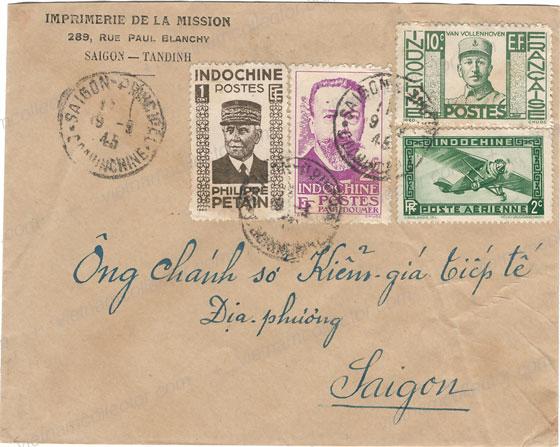
Many historians consider September 23, 1945 as the start of the French-Indochinese War. By that time, the United States under its new president Truman had changed her mind. Worried that The French may politically move into the camp of Russia they decided it would be the lesser evil to allow the French to recolonize Indochina after all. The French battleship “Richelieu” and the light cruiser “Triumphant” arrived on October 3rd in Saigon and the 5th Colonial Regiment from Sri Lanka disembarked. The 2nd French Army Division arrived in late October. The 9th Colonial Division arrives shortly thereafter aboard eight American ships. By the end of the year, fanning out from Saigon, the French controlled most of Indochina south of the 16th parallel.
Desrousseaux reports in SICP Journal 13 that the first French military post offices (Bureau Postale Militair/BPM) were set up in October of 1945 in Saigon and November in Hanoi. A BPM served a large area that included a number of provinces. Soldiers could send letters free of charge within the French military postal system but had to pay for additional services (i.e. registration, express mail, letters to countries other than France, etc.). Some BPM’s had annexes for civilian mail, especially immediately after the French take-over when the civilian postal system was still partially shut down in many areas. As per SICP member Ronald Bentley: ” Free mail was only recognized within the French community and outside letters fell under UPU regulations. To accommodate these cases, the letters were forwarded, by airmail, to the central military post office in Paris, where the proper international postage was added. The stamps were cancelled with the central post office’s postmark, the most common being the Bureau Poste Militaire “222” postmark.”
Below is a list, published by Desrousseaux in August of 1973:
- BPM 405 (Saigon), October, 1945
- Navy PN (Saigon), October, 1945
- BPM 411 (Hanoi, November, 1945
- BPM 136 (Phnom-Penh, February, 1946), 136 B (Kampot/Kratie, Fall of 1946)
- BPM 181
- BPM 401 (1954-1955)
- BPM 402, subsidiary 402A and 402B
- BPM 403, subsidiary 403A and 403 B, Civilian Annex 403XY (1946-1954)
- BPM 405, subsidiary 405A (opened in either December 1945 or January of 1946) and 405B
- BPM 406, subsidiary 406 B, Civilian Annex 406 (Hai-Phong) (1946-1955)
- BPM 407
- BPM 409, subsidiary 409 A and 409 B
- BPM 411, subsidiary 411A and 411 D (1945-1946)
- BPM 413, subsidiary 413 A
- BPM 414
- BPM 418, subsidiary 418A and 418 B, Civilian Annex 418 (Hue and Tourane)
- BPM 419A (Phnom-Penh)
- BPM 421, subsidiary 421 B (1950-1954)
- BPM 422, subsidiary 422 A
- BPM 423
- BPM 431 (Kratie, May of 1946)
Two blocks of four French and Indochinese stamps favor cancelled in the civilian annex of the BPM 403 XY post office:
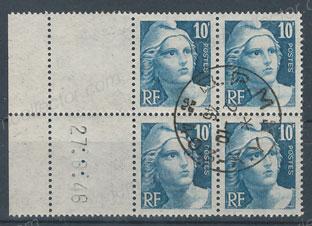
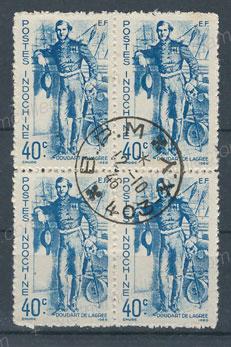
The troops used a “mute” Poste aux Armees” cancel with two six pointed stars (Desrousseaux A1 and B1) . The covers below show these cancels but with dates that makes them unlikely to have been used in Indochina, as the first Gurkha regiment arrived on September 12th and the other French troops were still imprisoned at that time. Fellow SICP member Ronald Bentley pointed out that these type of cancels were essentially “mobile cancels” that traveled with the respective troop unit. So, it is possible that the letters were sent as the soldiers were en route to Indochina or from a French army unit not connected at all to Indochina but using the same “mute” canceler in the field. The first letter mailed on August 26th, 1945 clearly identifies the sender as belonging to the “Forces Expeditionnaires Francaises en Extreme Orient” military service which was assigned to Indochina. The second letter only references “Corps Expeditionnaires S.P. 56.658, the once secret field post address which would have to be decoded and the author has been unable to do so. May be another collector has some information regarding this or knows where the 1st D.C.E.O. Corps des Exidants” was operating in early September, 1945.
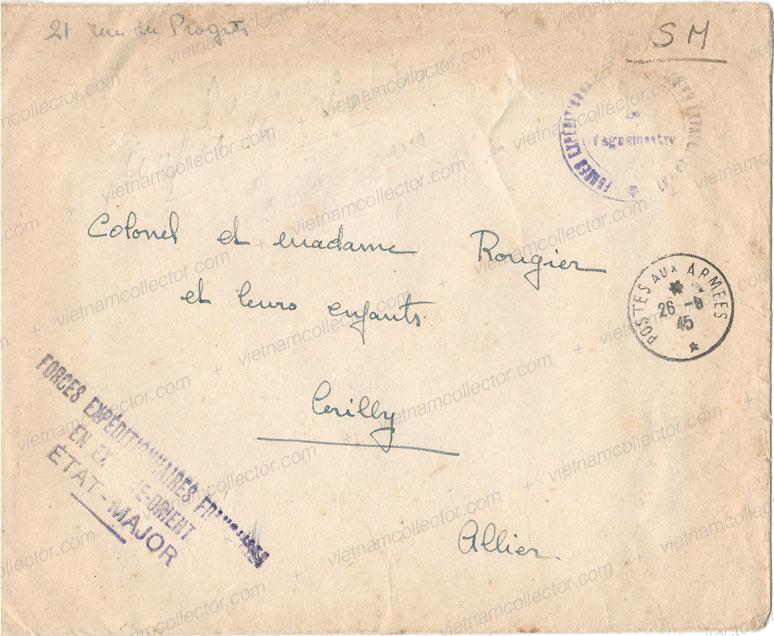
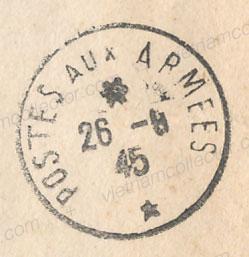
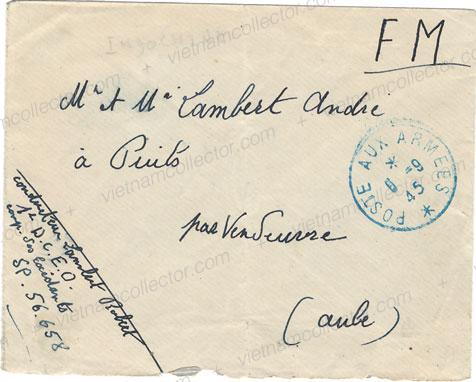
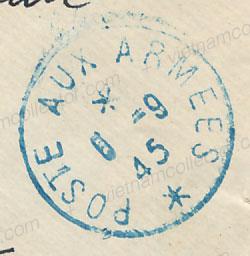
Another rare example of the use of the mute “Poste Aux Armees” cancel (Desrousseaux B1) with two stars using the “Franchise Militaire” postage free path and sent by a military Captain from Saigon to France in December of 1945. Military cachet on front and reverse.
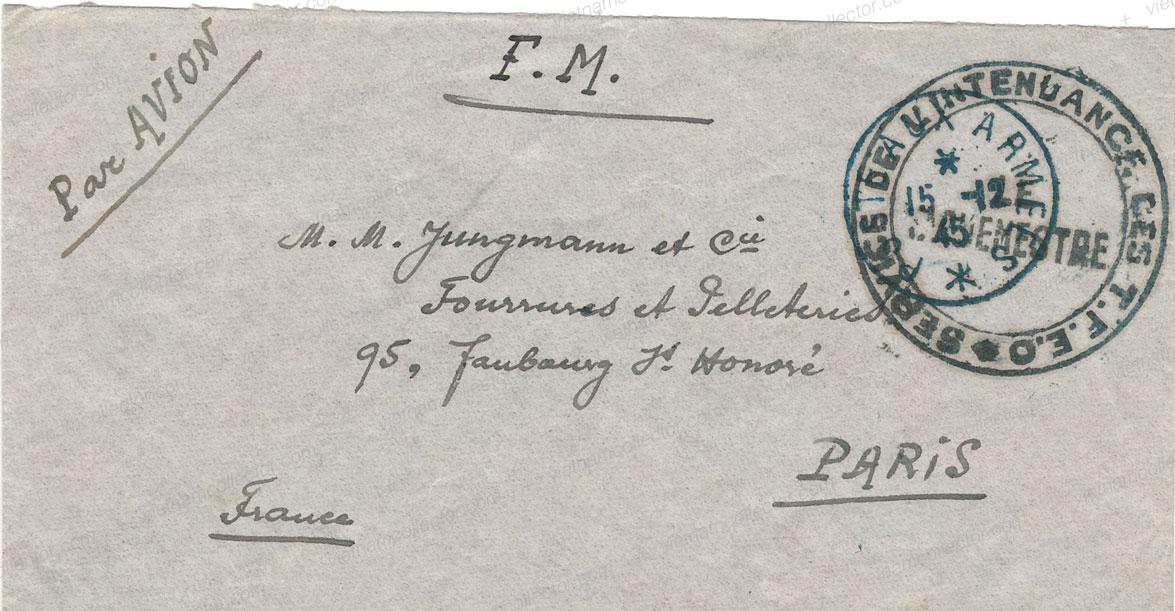
Another rare example, from a few dates later, of the use of the mute “Poste Aux Armees” cancel with two stars (Desrousseaux B1) using the “Franchise Militaire” postage free path and sent by a member of the military in S.P.50.521 to France in December of 1945. Signature of censor at lower left.
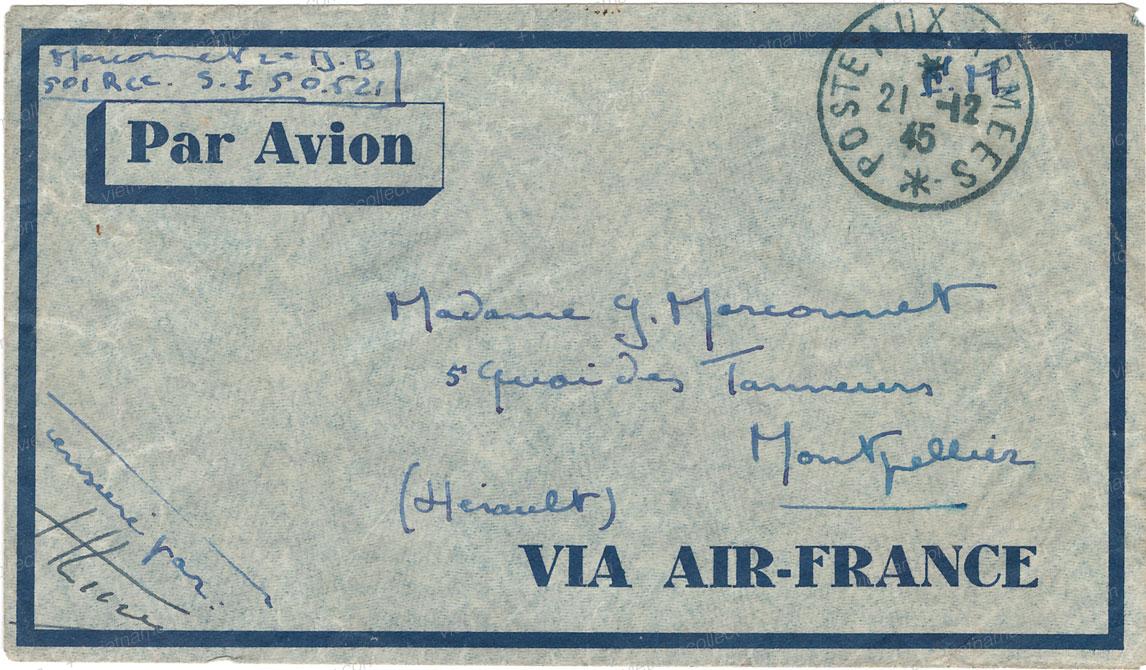
Individual 1 Centime Indochinese stamp cancelled with the early mute “Poste aux Armees” military cancel (Desrousseaux B1).
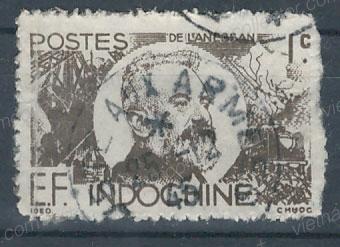
The first French plane that left, after dropping off General Leclerc on the 5th, left on October 6th. Goanvic reports on his website (historic-et-philatelie.fr) that the Saigon post office accepted mail free of charge as early as October 4th for two days only to be sent by military plane to France. The editor has never seen such a postage free letter cancelled on October 4th or 5th. According to Goanvic the first postage paid mail to France, Africa, the Levant and India was flown out on October 6th (which presumably also carried the postage free letters accepted two days earlier) but by the 6th it had to be franked with 15 cts for a 20g letter plus an airmail surcharge of 65 cts or 80 cts. However, the earliest civilian cover in the authors possession that documents the re-starting of civilian foreign mail in Saigon is dated October 26th, 1945. It features the 80 cts air mail tariff and has a civilian Saigon cancellation.
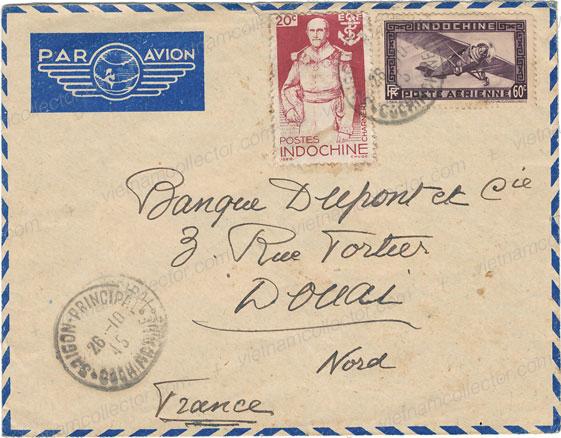
For Phnom Penh (Cambodia), as identified by the senders address on the back, the earliest date is October 29th but here the military carried out the mail service as it is cancelled with the “mute” Postes aux Armees” canceller (Desrousseaux B1) already described earlier.
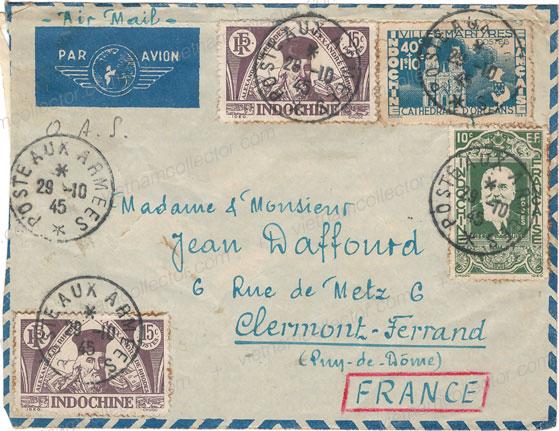
With the French Army taking over control in the South starting in October of 1945 the presence of the British soldiers was no longer required. Below is an article from the New York Times indicating that British forces prepared for their withdrawal already by December 9th, 1945 but the withdrawal dragged on into January of 1946.
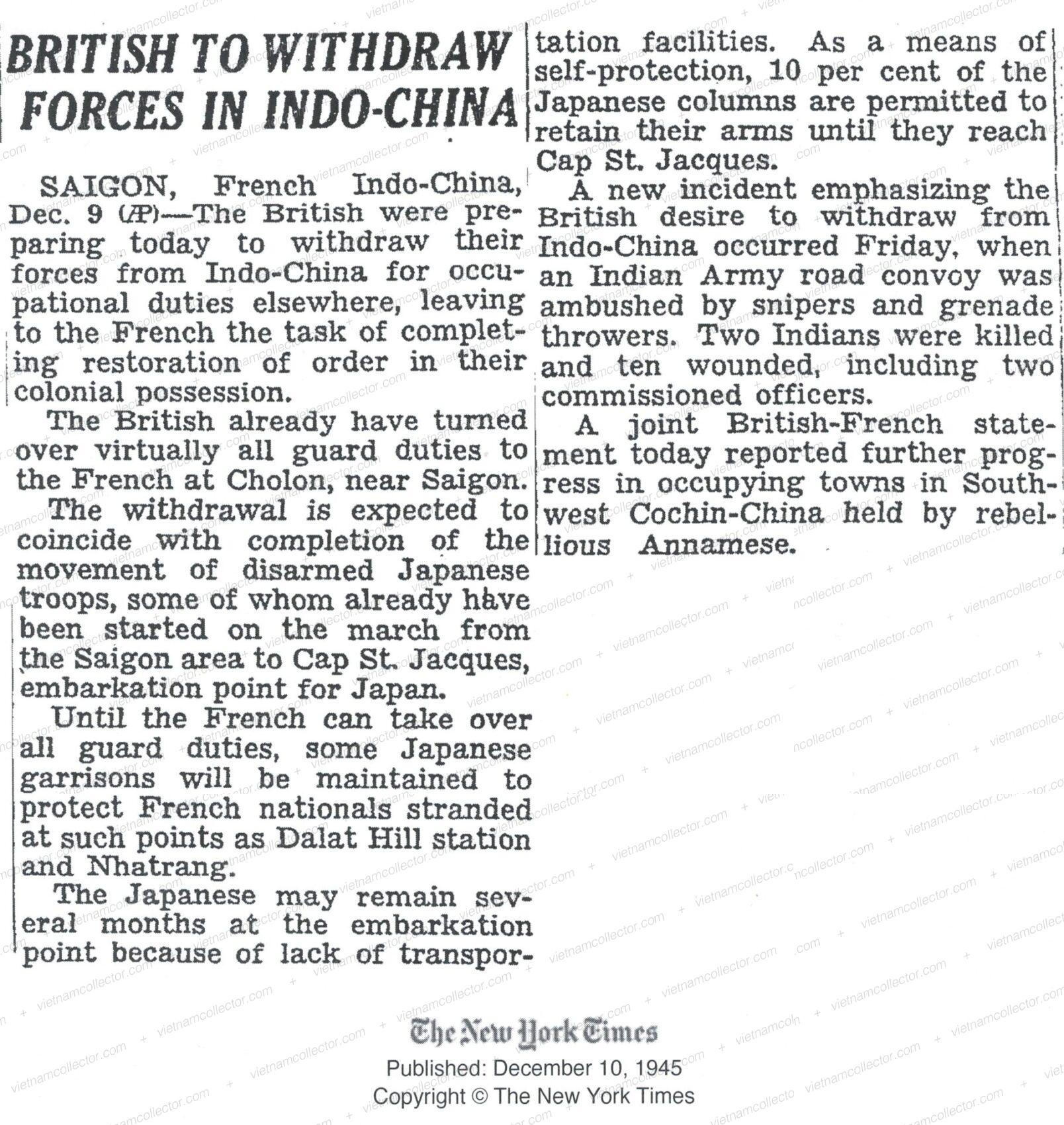
Here is a letter that was very likely mailed by a philatelic mindful British serviceman on November 29th, 1945 through the reopened civilian mail system. The letter carries two of the 50C Sports stamps together with four 20C Seafarer stamps paying an overall postage of 1.80P on an international air mail letter. It was sent from Saigon to Nottingham in England and remains unopened to this day.
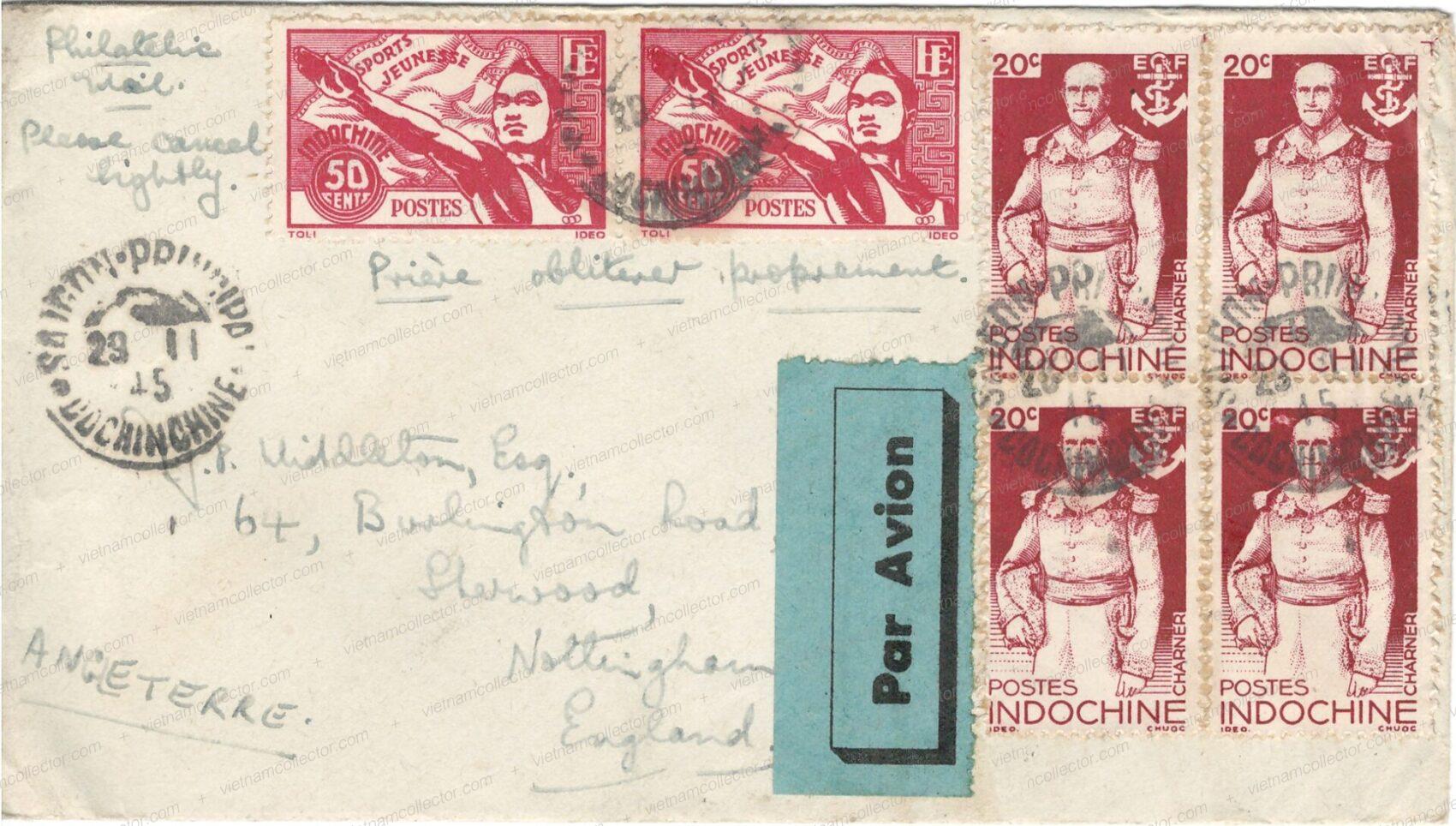
The mobile cancel shown in the two letters above must have been in operation only for a few weeks in October and sporadically later on as the letter below shows. This letter, directed to Metz in France was mailed on December 25th, 1945 and it was cancelled with a Poste aux Armes cancel (Desrousseaux C1) that already carried the addition “T.O.E.” at the bottom.
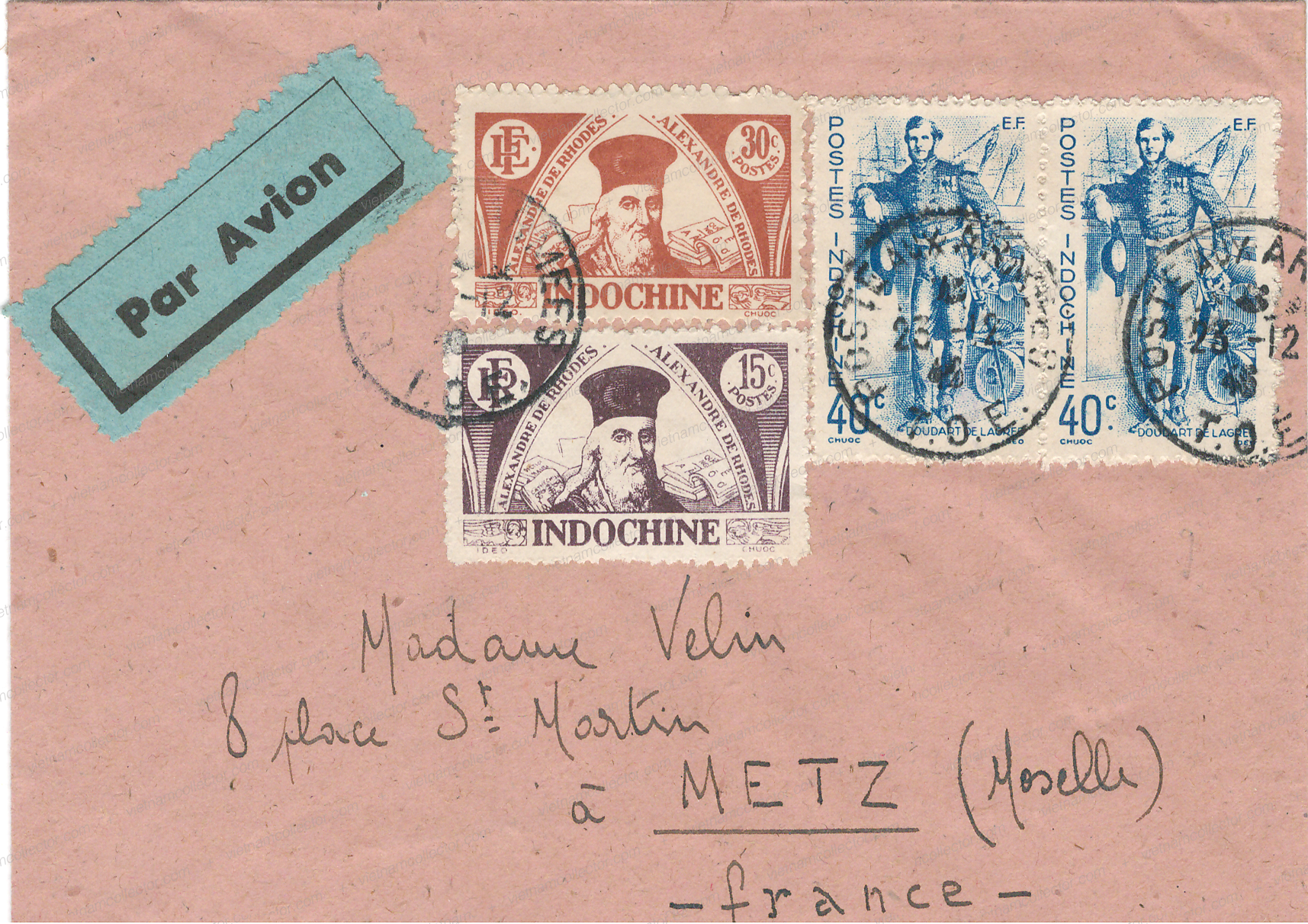
Desrousseaux wrote in SICP Journal 13 about how civilian mail was handled at the time: “Because the French had no agreements with the Government of North Vietnam, the VIIDCClI post could not send mail outside the country so the French BPM moved the mail between Hanoi and Saigon. Civilian mail was post-free in October and November 1945, but after that, paid the normal French charge (1.50FF for domestic letters, 2FF for letters to France; the registration fee amounted to 4FF). The covers bear French postage stamps cancelled by the postmarks of BPM 411 and then BPM 403. About October 1946, they created an “annexe” for civilian mail only, 403XY. Then the annexes of Haiphong, Tourane and. Hue were opened. After the battle of Hanoi, December 20th, the VDCCH post offices were closed and occupied by the French Army and so the annexes had to handle the internal mail for North Vietnam too. Some of the annexes were transferred to civil post offices until the reorganization of a civil service in the second quarter of 1947 permitted reopening the civil post offices, The BPM annexes disappeared at that time.”
It is interesting to note that the stamps used for civilian mail at the time were mostly French as local Indochinese stamps had become short in supply. Recall that the Viet Minh overprinted a large quantity of Indochina stamps with their own country name and values and so made them unusable for the French later on. Desrousseaux reports though, that sometimes the BPM’s would accept Indochinese stamps if they were available.
Below is a rare civilian registered letter that was sent from BPM 411 in December of 1945 from Hanoi to France paying a tariff of 6 FF (2FF for the letter and 4FF for registration). Desrousseaux had timed the first occurrence of the cancel to May of 1946 but this letter proves that the cancel was already operational months before. Goanvic reports that the office was opened on November 1st, 1945 which is likely the correct date. Seloncourt arrival cancel on the reverse.
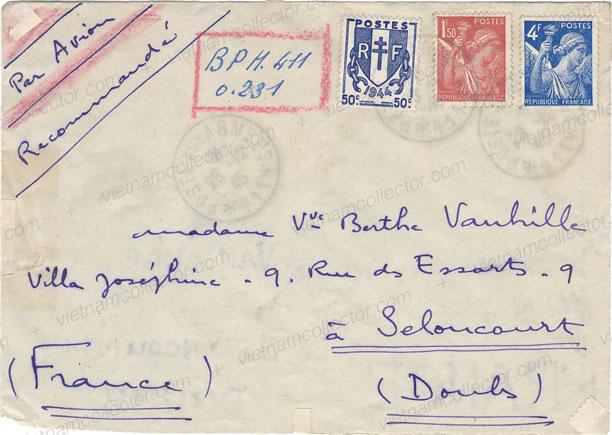
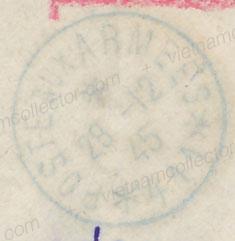
Unusal multiple franking of French stamps and paying an overall postage of 36FF on an air mail letter sent by the “Establishment Boy-Landry” in Hanoi to a Colonial Commission in Marseille, France. Though the letter was of civilian nature it was processed by the French military postal system as evidenced by the rare “mute” Poste aux Armee military cancel (Desrousseaux B1) with the two six sided stars.
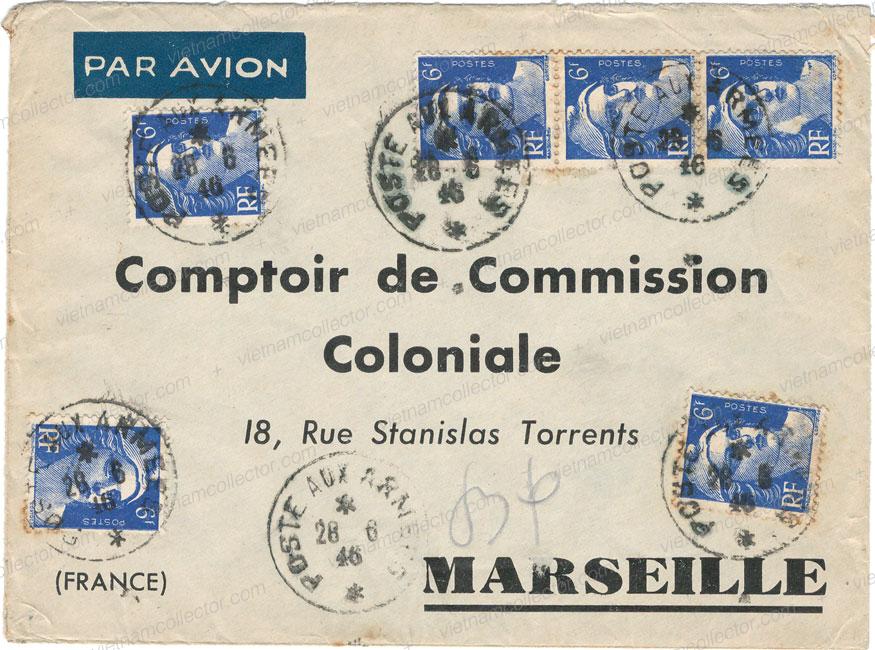
Civilian letter sent through BPM 403 in Hanoi to Avignon in France paying an overall postage of 25 FF. Since Indochinese stamps had run out (remember that most of the old stocks had been overprinted by the Viet Minh in December of 1945) French postage stamps were used. Cancelled with the mute “B.P.M. 403” cancel of the civilian section of the post office.
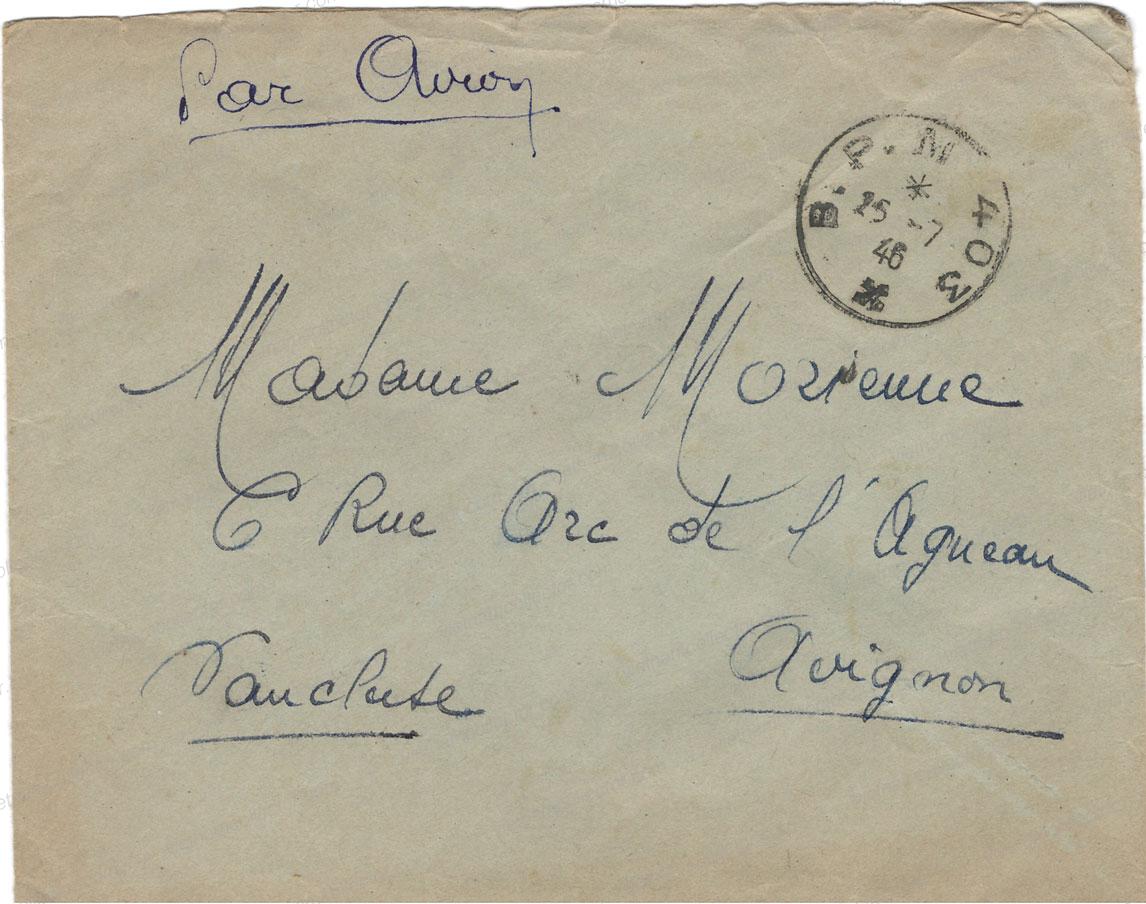
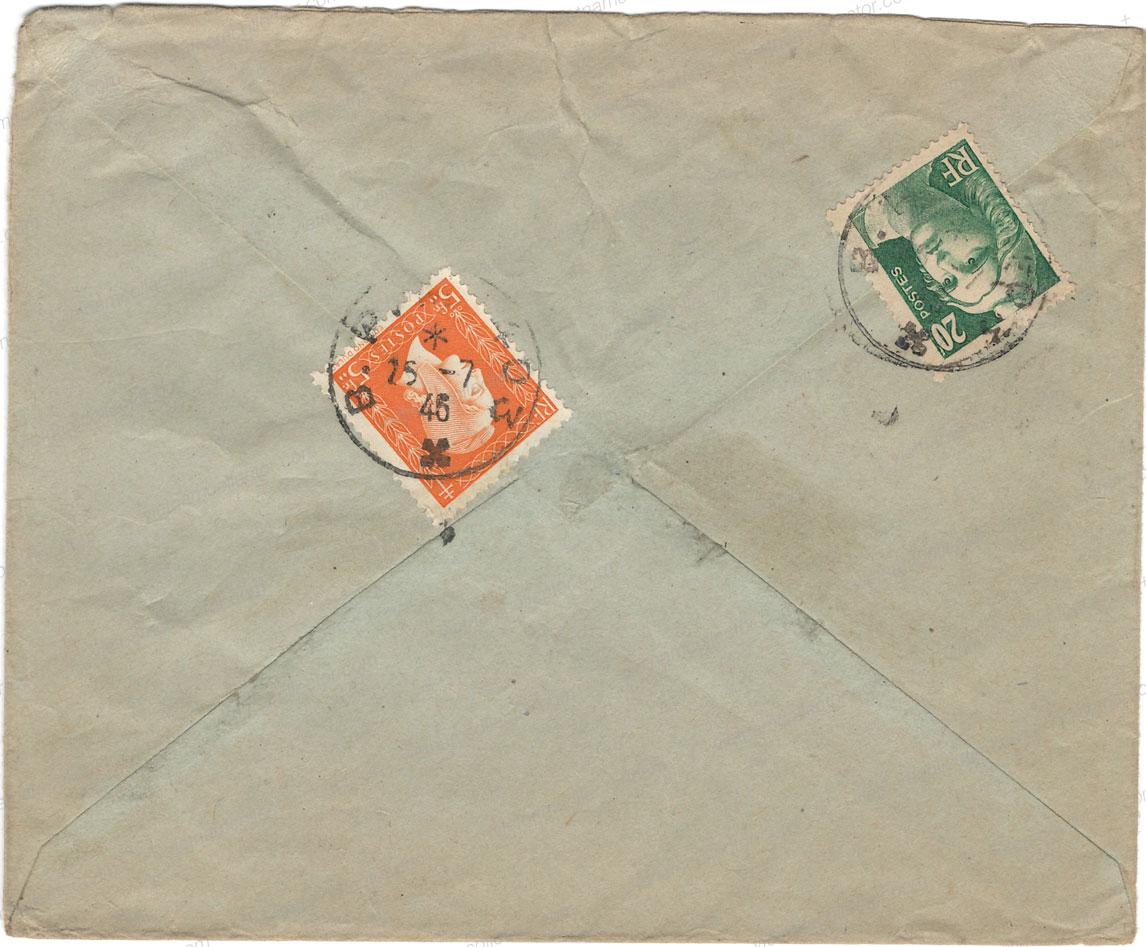
Civilian letter sent through BPM 403 in Hanoi to Saigon by registered mail paying an overall postage of 9 FF. Black “B.P.M. 403 Annexe de Hanoi” cachet on front. Saigon civilian arrival cancels on the reverse from November 12th, 1946 so the letter took four days to be transported. The domestic letter rate was changed to 3FF in January of 1946 with the registration fee amounting to 6FF.
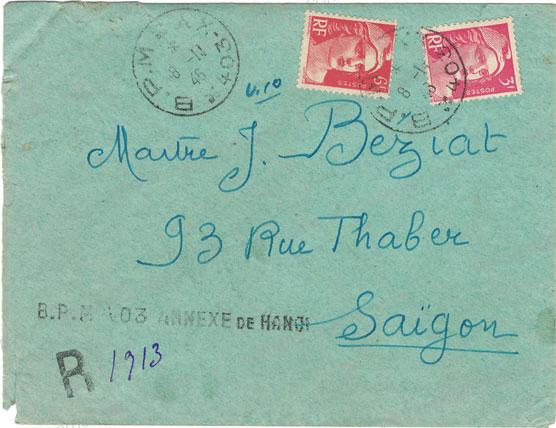
Philatelic letter sent by a French soldier located in Secteur Postale 50678 (BPM 411) from BPM 403 to France in July of 1946. Cancelled with the mute “Poste aux Armees 403” cancel (Desrousseaux K1). This was prior to the clash of Hanoi. While the Indochinese stamps overprinted by the Viet Minh were valid postage for domestic mail at the time this was not the case for international mail. The Viet Minh stamps on this letter were also not necessary as the soldiers mail was postage free anyway. They were simply attached for philatelic reasons but the French postal officer did not bite and refused to cancel the illegitimate stamps. Also, the soldier, in contravention of orders, wrote both his S.P. and BPM number on the envelope. This was illegal as it might have enabled the enemy to follow troop movements but this rule was not strictly enforced in the early days when the French were still somewhat cooperating with the Viet Minh in an uneasy truce.
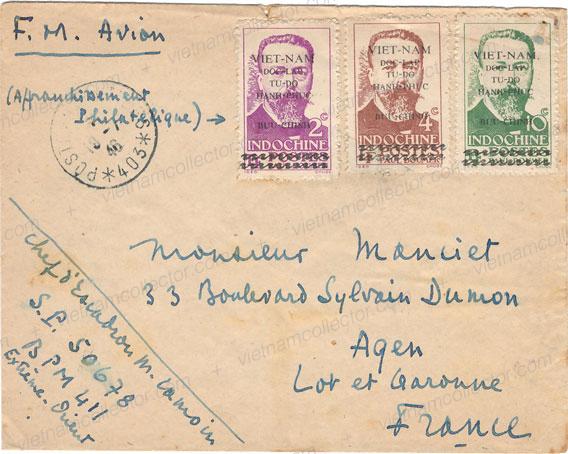
Civilian registered air mail letter sent from BPM 403 in Hanoi to France in September of 1946 paying a 40 FF postage. Black “B.P.M. 403 Annexe de Hanoi” cachet on front. Cancelled with the civilian “mute” B.P.M. 403 date canceller (Desrousseaux Type T).
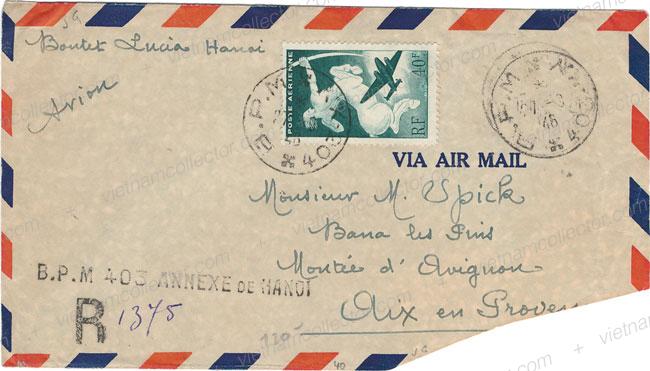
Civilian letter paying an overall postage of 6FF sent through BPM 403 in Hanoi to France in December of 1946. Cancelled with the “mute” B.P.M. 403X cancel (Desrousseaux Type T). Interestingly the letter has a transit cancel from Saigon on May 10th, 1947 which suggest that this letter got marooned months before it was transported.
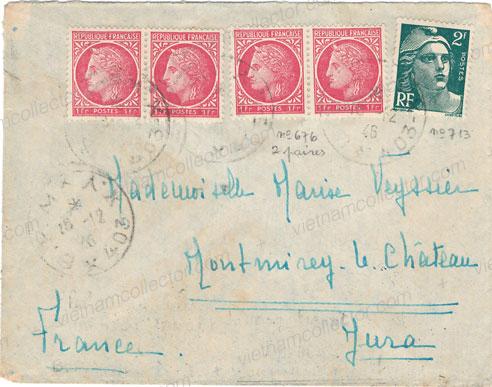
Civilian registered air mail letters eta from BPM 403 to France in December of 1946 paying an overall postage of 30 FF. Black “B.P.M. 403 Annexe de Hanoi” cachet on front. Cancelled with the “mute” B.P.M. 403X cancel (Desrousseaux Type T). Besancon arrival cancel on the reverse.
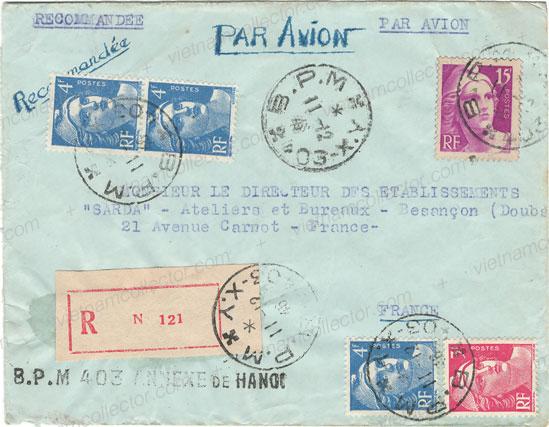 Corporate registered air mail letter sent by the Standard-Vacuum Oil Company from BPM 403 in Hanoi to the United States in December of 1946 paying an overall postage of 77.6 FF. Black “B.P.M. 403 Annexe de Hanoi” cachet on front. Cancelled with the “mute” B.P.M. 403 /Desrousseaux Type Q). Chicago arrival cancels on the reverse.
Corporate registered air mail letter sent by the Standard-Vacuum Oil Company from BPM 403 in Hanoi to the United States in December of 1946 paying an overall postage of 77.6 FF. Black “B.P.M. 403 Annexe de Hanoi” cachet on front. Cancelled with the “mute” B.P.M. 403 /Desrousseaux Type Q). Chicago arrival cancels on the reverse.
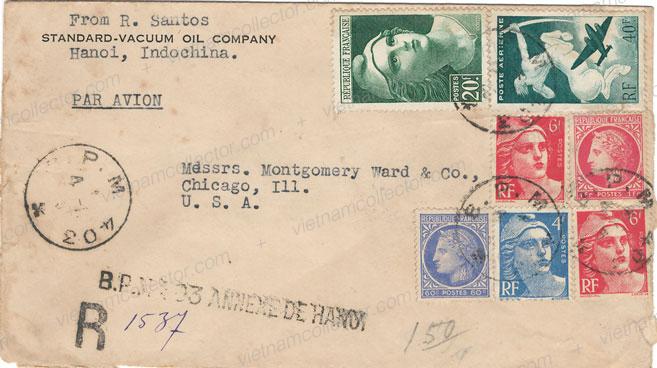 Civilian air mail letter sent in April of 1946 from BPM 411 A in Hai Phong to France paying an overall postage of 3 FF. Cancelled with the “mute” Poste aux Armees” military cancel (Desrousseaux Type K1).
Civilian air mail letter sent in April of 1946 from BPM 411 A in Hai Phong to France paying an overall postage of 3 FF. Cancelled with the “mute” Poste aux Armees” military cancel (Desrousseaux Type K1).
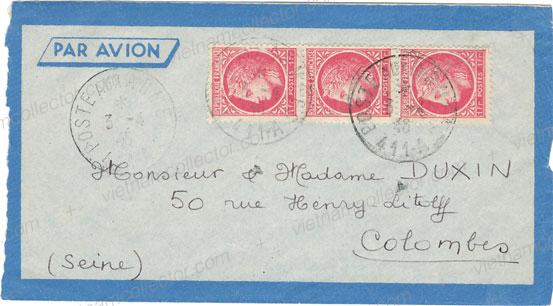 Civilian air mail letter sent in June of 1946 from BPM 411 A in Hai Phong to Saigon paying an overall postage of 3 FF. Saigon arrival cancel on the reverse. Cancelled with the “mute” Poste aux Armees” military cancel (Desrousseaux Type K1).The letter took only two days to be transported.
Civilian air mail letter sent in June of 1946 from BPM 411 A in Hai Phong to Saigon paying an overall postage of 3 FF. Saigon arrival cancel on the reverse. Cancelled with the “mute” Poste aux Armees” military cancel (Desrousseaux Type K1).The letter took only two days to be transported.
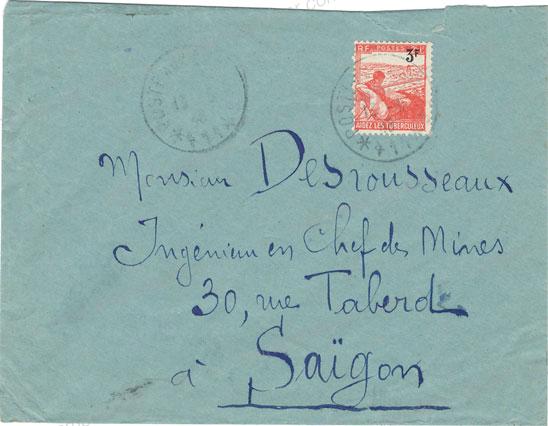 Interesting domestic air mail letter that was sent in June of 1946 by a civilian in Hue to a civilian in Hanoi. Instead of being cancelled with the B.P.M. 418 annex cancel it was cancelled with the mute military “Poste Aux Armees” that was normally used for postage free soldier mail (Desrousseaux Type B1).
Interesting domestic air mail letter that was sent in June of 1946 by a civilian in Hue to a civilian in Hanoi. Instead of being cancelled with the B.P.M. 418 annex cancel it was cancelled with the mute military “Poste Aux Armees” that was normally used for postage free soldier mail (Desrousseaux Type B1).
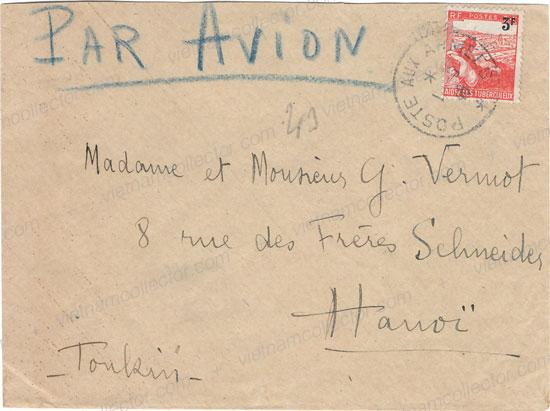 Commercial letter sent by the Cotonniere du Tokin to a client tin the United States in September of 1946. The letter was mailed in BPM 403 in Hanoi and the overall postage amounted to 32 FF. Cancelled with the “mute” B.P.M. 403 military cancel (Desrousseaux Type Q).
Commercial letter sent by the Cotonniere du Tokin to a client tin the United States in September of 1946. The letter was mailed in BPM 403 in Hanoi and the overall postage amounted to 32 FF. Cancelled with the “mute” B.P.M. 403 military cancel (Desrousseaux Type Q).
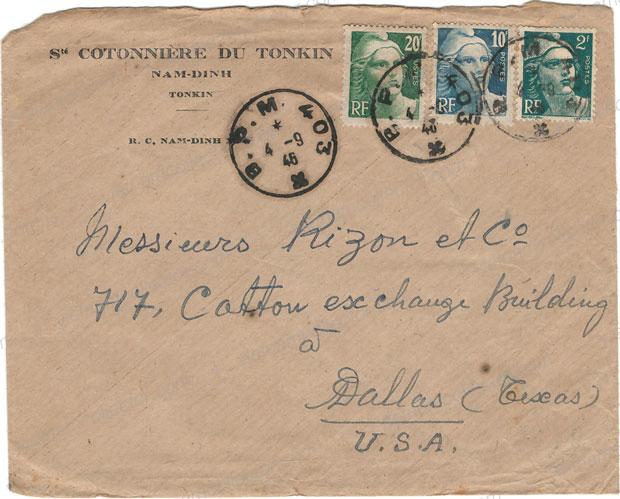 Civilian letter sent in October of 1946 from BPM XY to France paying an overall postage of 69 FF. Civilian Saigon transit cancel on the reverse. Cancelled with the “mute” B.P.M. 403 military cancel (Desrousseaux Type T).
Civilian letter sent in October of 1946 from BPM XY to France paying an overall postage of 69 FF. Civilian Saigon transit cancel on the reverse. Cancelled with the “mute” B.P.M. 403 military cancel (Desrousseaux Type T).
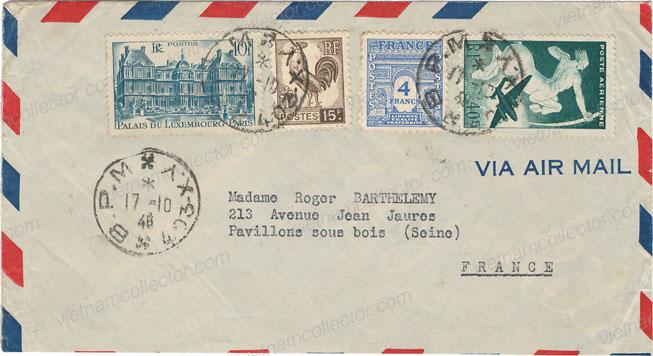 For a short time some BPM’s had run out of French and Indochinese postage stamps in the spring of 1946. As a result hectograph labels were created as an emergency measure and used instead of stamps. Below are two registered letters mailed from BPM 405 to Saigon in March of 1946. Cancelled with the “mute” Poste aux Armes” military cancel (Desrousseaux Type K1).Rare.
For a short time some BPM’s had run out of French and Indochinese postage stamps in the spring of 1946. As a result hectograph labels were created as an emergency measure and used instead of stamps. Below are two registered letters mailed from BPM 405 to Saigon in March of 1946. Cancelled with the “mute” Poste aux Armes” military cancel (Desrousseaux Type K1).Rare.
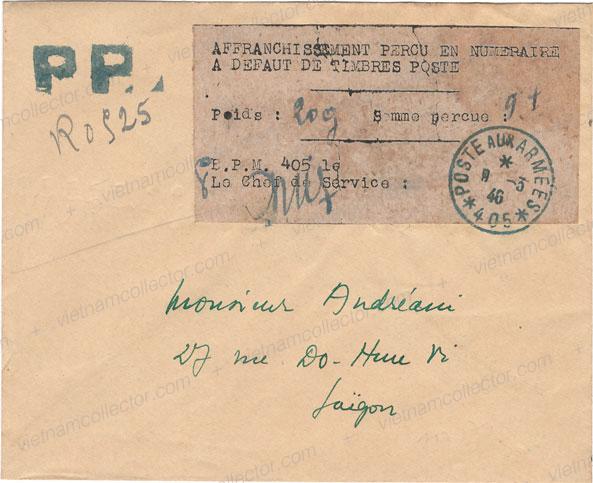
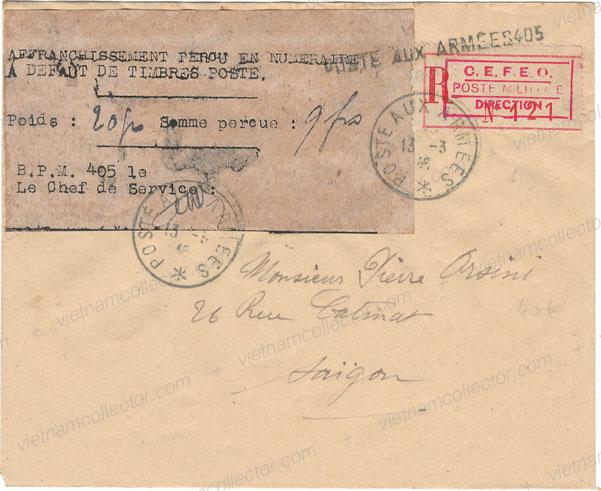
Here is a letter processed through BPM 402 carrying the provisional stamp label paying a 9C postage on a letter to military unit SP 50636. Cancelled with the mute “Poste aux Armees 402” cancel (Desrousseaux Type K1). Red military cachet on front. T.O.E. arrival cancel on the reverse.
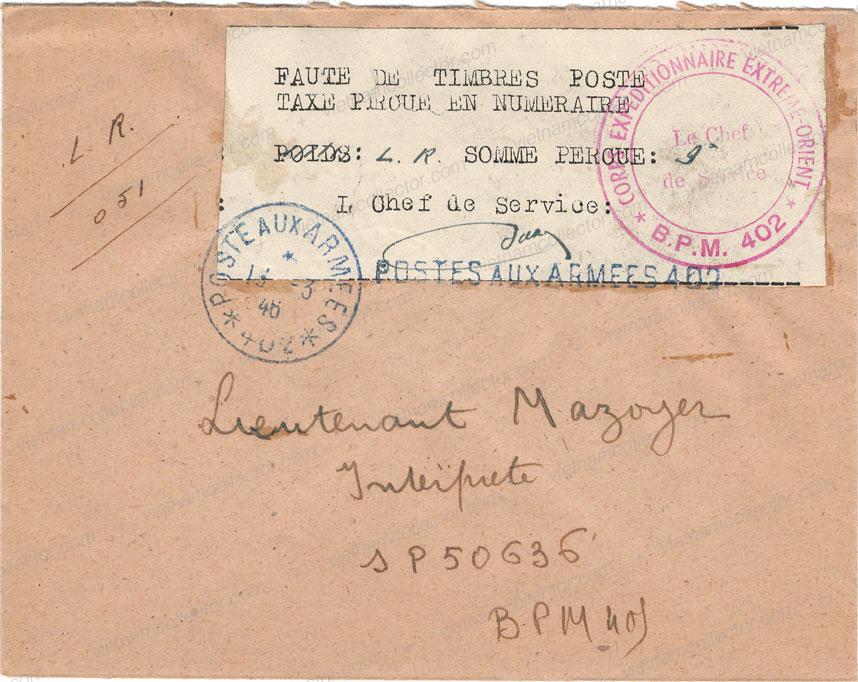
Here is a letter processed through BPM 403 carrying the provisional stamp label paying a 9C postage on a letter to a civilian in Saigon. Cancelled with the mute circular “Poste aux Armees 403” cancel (Desrousseaux Type L2). “Post aux Armees 403-A” bar cachet on front.
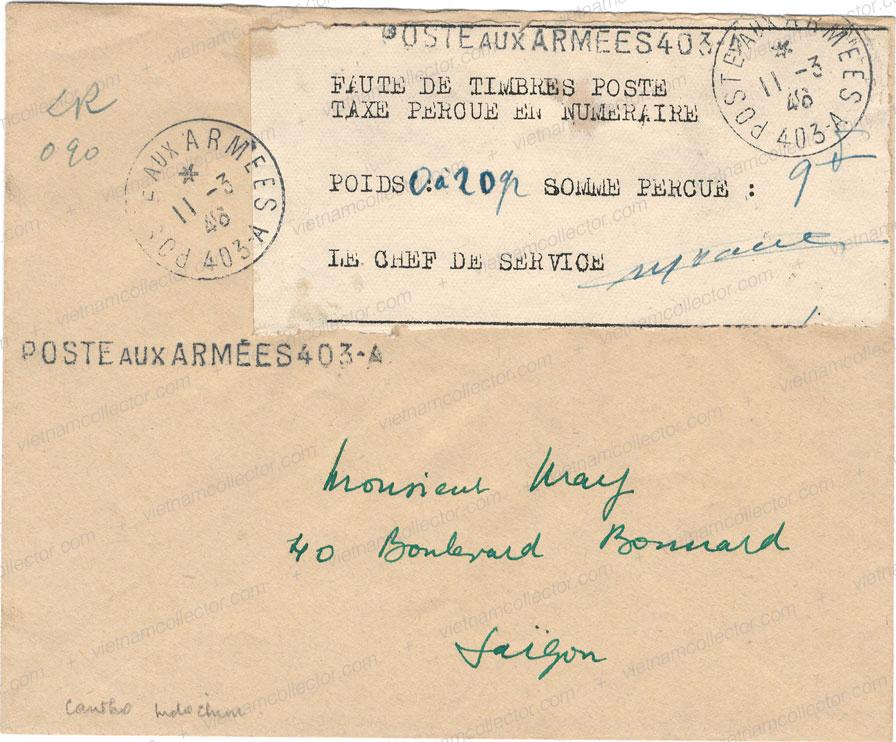
Domestic letter that apparently was sent by a civilian located in January of 1946 in BPM 418 in Tourane (Da Nang) to a soldier located in Secteur Postale 50630 paying 3 FF.
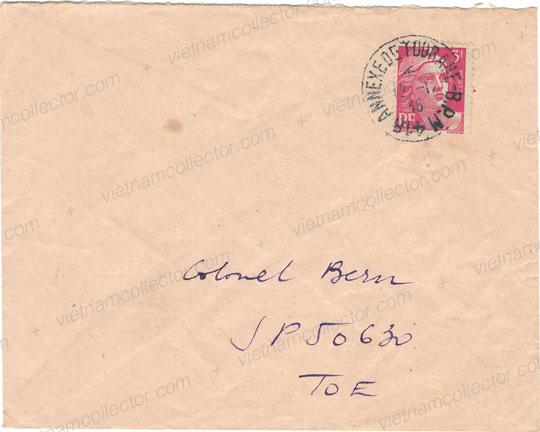
International air mail letter sent by a civilian located in Hanoi to France in January of 1946 and paying a 2 FF postage. Unusually it was not processed through the civilian annex of the BPM but the military side that used the mute “Poste aux Armees” military cancel.
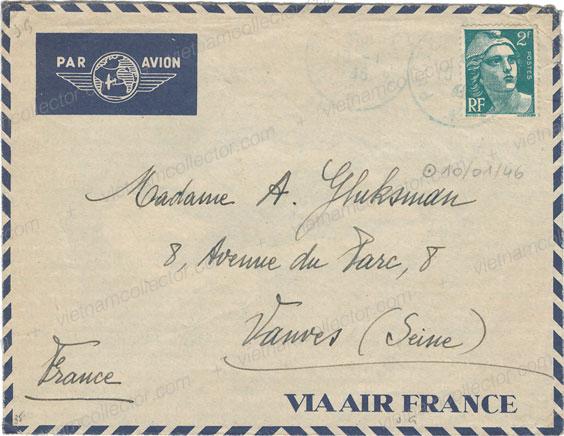
International air mail letter sent by a civilian located in Hanoi to France in April of 1946. The letter was franked with 3 FF but unusually was not processed through the civilian annex of the BPM but the military side that used the mute “Poste aux Armees” military cancel.
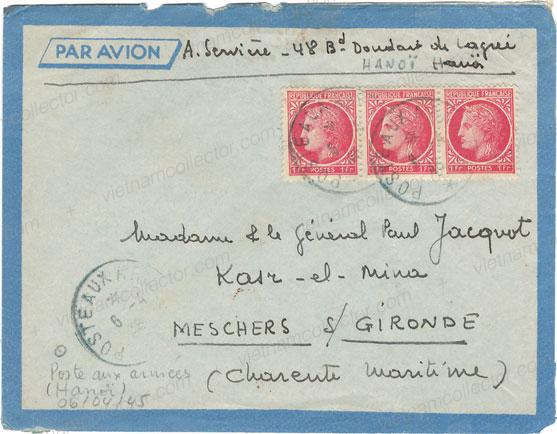 Commercial Red Cross letter sent from Hanoi to France in February of 1946. The letter was franked with a total postage of 3 FF . Instead of being processed through the civilian branch of the BPM it was processed by the military side using the mute “Poste aux Armees” military cancel.
Commercial Red Cross letter sent from Hanoi to France in February of 1946. The letter was franked with a total postage of 3 FF . Instead of being processed through the civilian branch of the BPM it was processed by the military side using the mute “Poste aux Armees” military cancel.
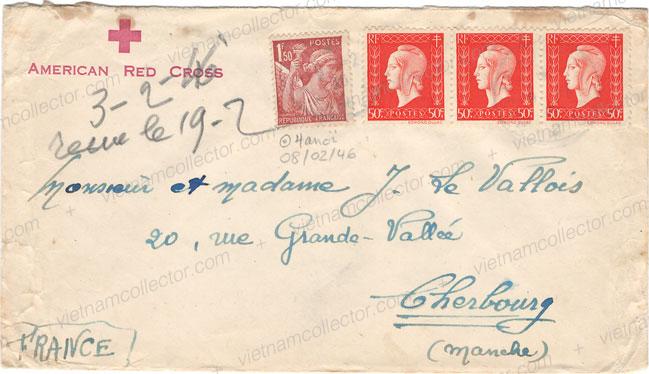
Military air mail letter by a French soldier located in Secteur Postal 50678 to a civilian In France using the Franchise Military free frank privileges in June of 1946. Black Frank-Vietnamese Regimental cachet on front. Cancelled by the mute “Poste aux Armees” military cancel of BPM 403.
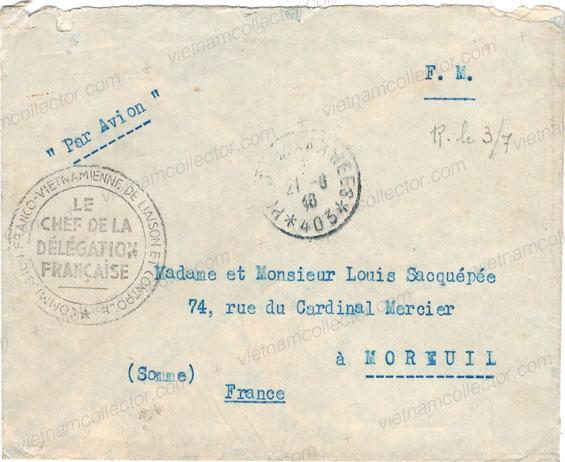
International air letter sent by a civilian located in Hue (BPM 418) in September of 1946. The letter was franked with 3.2 FF.
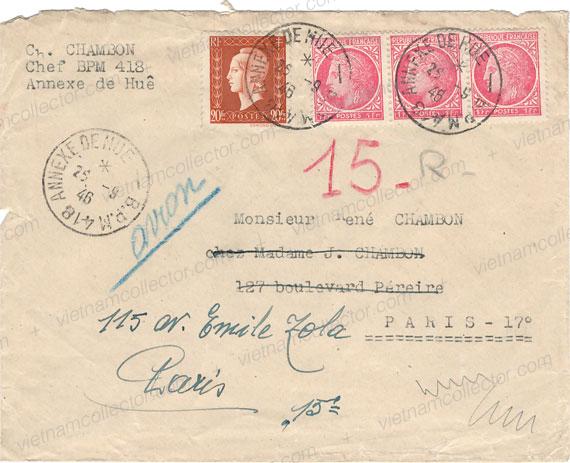 Military letter sent by a soldier located in S.P. 53381 (apparently a naval unit) sent to France in November of 1946 using the Franchise Militaire (F.M.) free frank privileges. Cancelled with the “mute” Poste aux Armees military cancel (Desrousseaux Type C1).Oval black S.P. cachet on top.
Military letter sent by a soldier located in S.P. 53381 (apparently a naval unit) sent to France in November of 1946 using the Franchise Militaire (F.M.) free frank privileges. Cancelled with the “mute” Poste aux Armees military cancel (Desrousseaux Type C1).Oval black S.P. cachet on top.
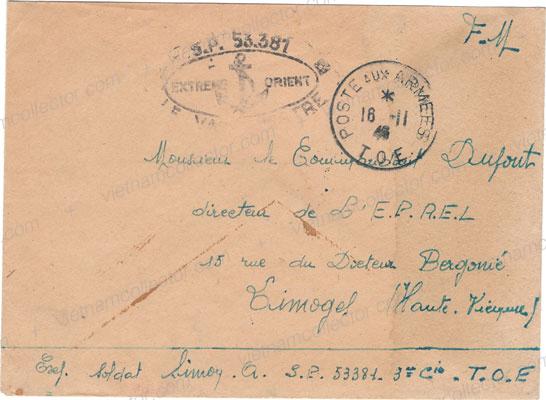
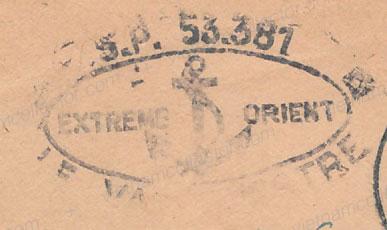
Military letter sent by a soldier located in S.P. 50.665 sent to France using the Franchise Militaire (F.M.) free frank privileges. Unusual circular S.P. cachet on top right. These circular military cachets were the precursor to the K.B.C. cachets later used by the South Vietnamese military.
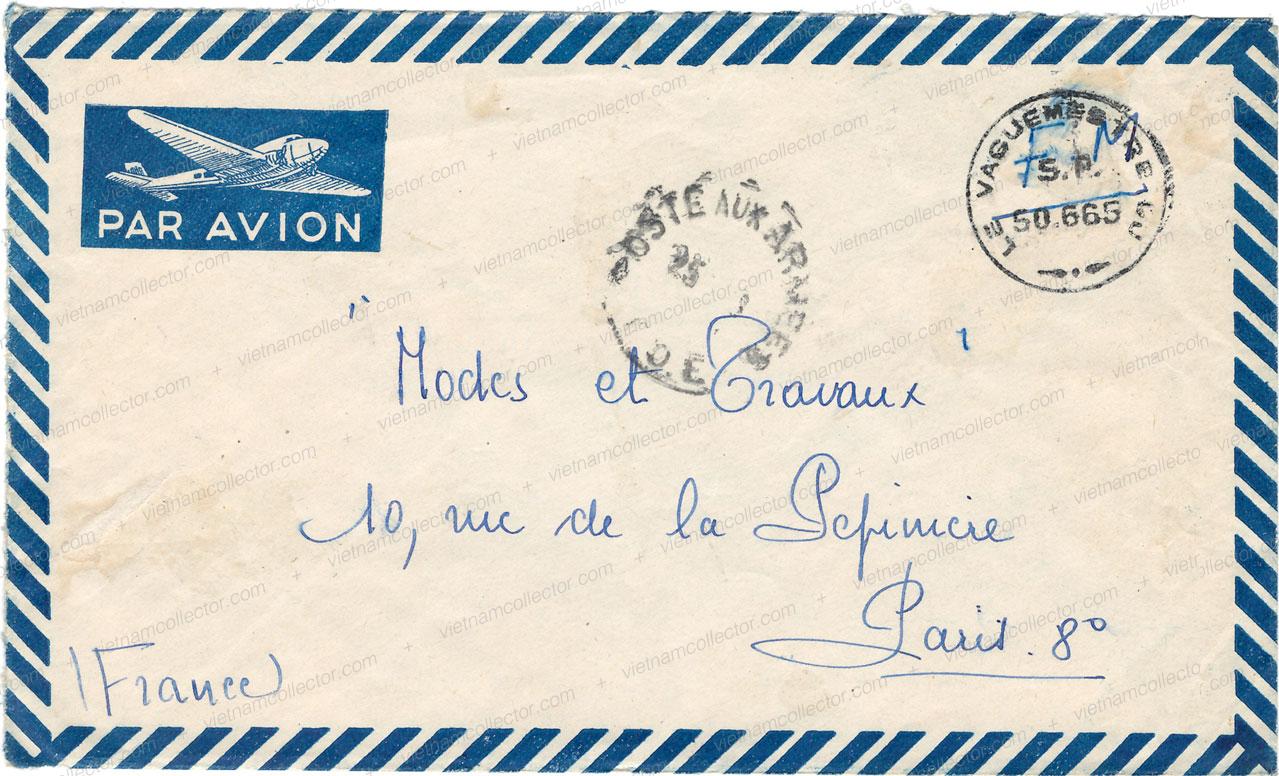
Air mail letter of a German soldier located in S.P. 82388 which apparently was part of the French Foreign Legion sent to the well known philatelist Theo Klewitz in February of 1947 and paying a total postage of 10 FF. Cancelled with the “mute” Poste aux Armees military cancel (Desrousseaux Type C1).Had the letter been addressed to France it would have been postage free. The State of Hesse was located in the American Zone in Germany at the time and was censored upon arrival by the civilian censorship office (P.K.T.). Red Foreign Legion cachet at bottom left. Immediately after the war France started to offer former Nazis captured in the war to chose between the option of either the death penalty or long prison sentence or serving in the French Foreign Legion. Many Germans decided to fight and hence ended up in Indochina.
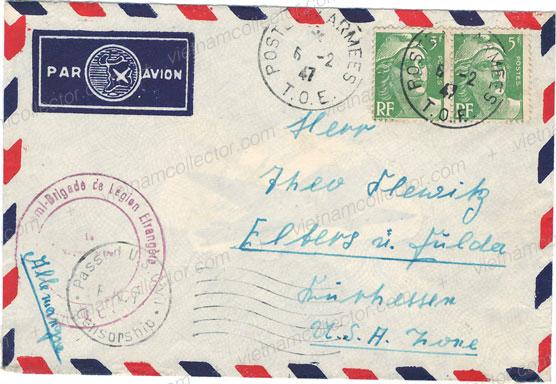 Letter from the same correspondence sent by a German soldier located in S.P. 82388 which apparently was part of the French Foreign Legion sent to the well known philatelist Theo Klewitz in April of 1947 and paying a total postage of 10 FF. Had the letter been addressed to France it would have been postage free. The State of Hesse was located in the American Zone in Germany at the time and was censored upon arrival by the civilian censorship office “B”. Immediately after the war France started to offer former Nazis captured in the war to chose between the option of either death penalty or long prison sentence or serving in the French Foreign Legion. Many Germans decided to fight and hence ended up in Indochina.
Letter from the same correspondence sent by a German soldier located in S.P. 82388 which apparently was part of the French Foreign Legion sent to the well known philatelist Theo Klewitz in April of 1947 and paying a total postage of 10 FF. Had the letter been addressed to France it would have been postage free. The State of Hesse was located in the American Zone in Germany at the time and was censored upon arrival by the civilian censorship office “B”. Immediately after the war France started to offer former Nazis captured in the war to chose between the option of either death penalty or long prison sentence or serving in the French Foreign Legion. Many Germans decided to fight and hence ended up in Indochina.
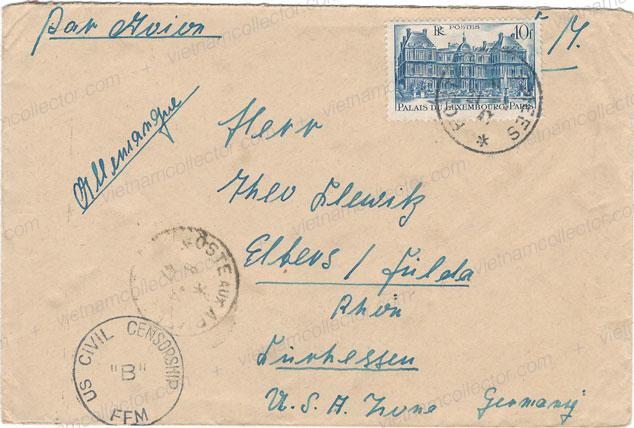
Letter sent by a German member of the French Foreign Legion (S.P. 82 006/BPM 414) in April of 1947 to a civilian in the Soviet Zone in East Germany. The letter was sent under the “Franchise Militaire (F.M.) free mail privileges but these were only extended inside the French Union. So the letter had to be unfranked with 10 FF in Paris before it was forwarded to the addressee. Black French Foreign Legion cachet on front.
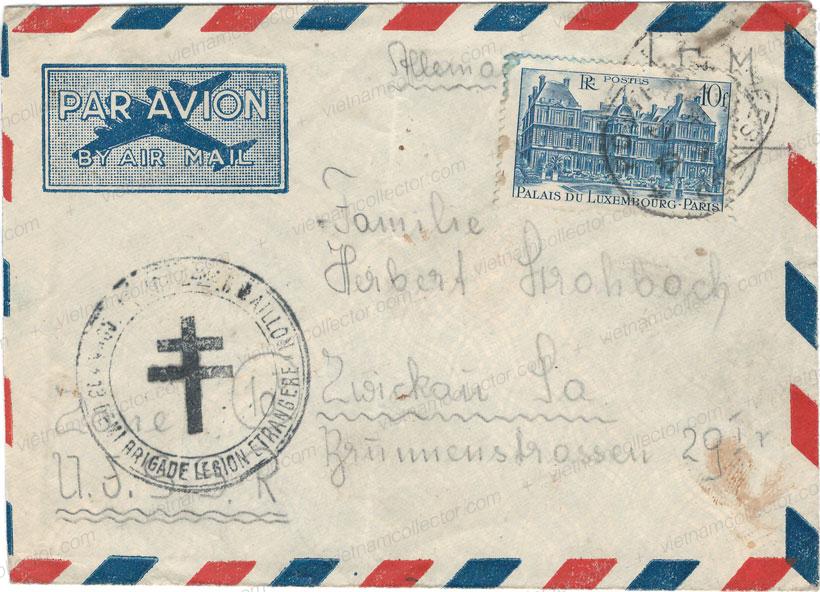
Rare usage of Indochinese stamps paying an overall postage of 1.341 Piastre on an international letter sent by a Sargent located in a Hospital in Saigon to France in May of 1947. Because the soldier was an officer he did not have free mail privileges and hence had to affix stamps. Cancelled with the mute “Poste aux Armees” military cancel.
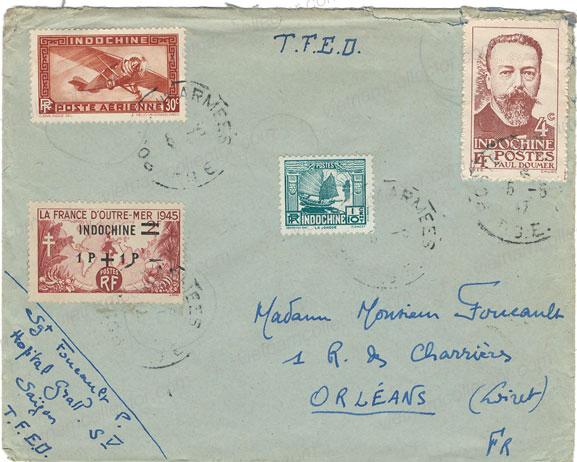 Rare civilian usage of Indochinese stamps from BPM 403 located in Hanoi in February of 1947 to a recipient in Saigon paying an overall postage of 40 Centimes. Cancelled with the “mute” B.P.M. 403 military cancel (Desrousseaux Type Q).Saigon arrival cancel of Ferry 13th, 1947. The letter took only two days.
Rare civilian usage of Indochinese stamps from BPM 403 located in Hanoi in February of 1947 to a recipient in Saigon paying an overall postage of 40 Centimes. Cancelled with the “mute” B.P.M. 403 military cancel (Desrousseaux Type Q).Saigon arrival cancel of Ferry 13th, 1947. The letter took only two days.
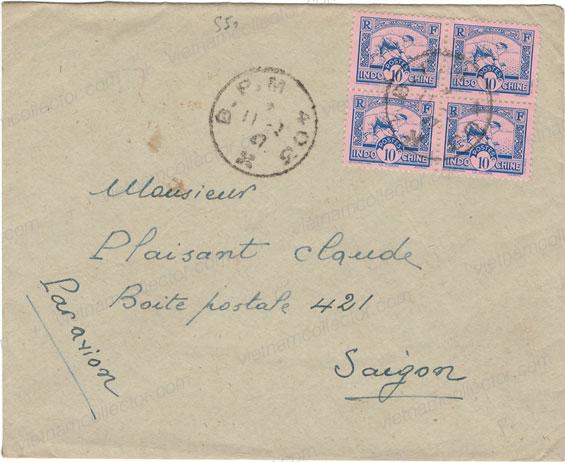 Letter mailed by the Commander of the Administrative Office of the Extreme Orient to a company in Rangoon, Burma. The letter was of military origin possibly dealing with supplies. Cancelled with the “mute” Poste aux Armees military cancel (Desrousseaux Type C1).It was apparently mis-sent to “Steel Brothers” which the recipient annotated by stating “Not Steel Brothers” while another person annotated “Standard Vacuum Oil Company”. French military cachet at bottom left. Cancelled by the mute “Poste aux Armees” military cancel. Various arrival cancels and an interesting cachet on the reverse.
Letter mailed by the Commander of the Administrative Office of the Extreme Orient to a company in Rangoon, Burma. The letter was of military origin possibly dealing with supplies. Cancelled with the “mute” Poste aux Armees military cancel (Desrousseaux Type C1).It was apparently mis-sent to “Steel Brothers” which the recipient annotated by stating “Not Steel Brothers” while another person annotated “Standard Vacuum Oil Company”. French military cachet at bottom left. Cancelled by the mute “Poste aux Armees” military cancel. Various arrival cancels and an interesting cachet on the reverse.
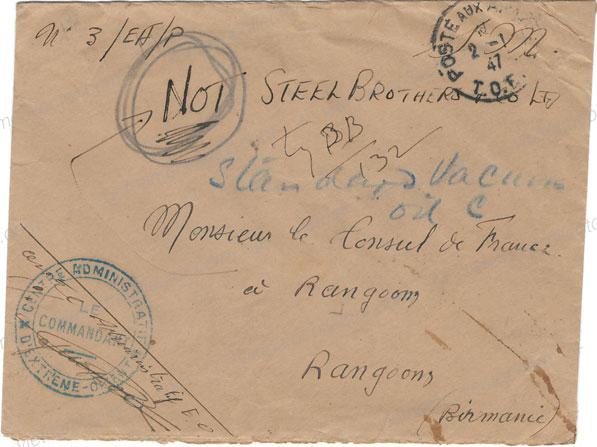
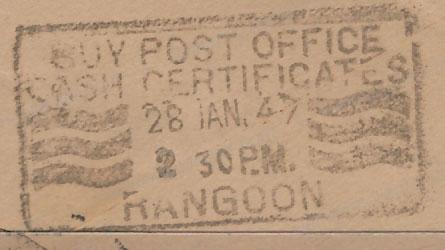
Domestic military letter sent by a member of the “Brigade de Marches des Trailleurs” which was a rifle brigade in August of 1947 using the postage free FM (Franchise Militaire) privilege to a civilian in My Tho. Military cachet on front. The letter was cancelled with the mute “Posted aux Armees T.O.E” military cancel (Desrousseaux Type C1). Cachet of “KHAN” (Urgent) on front.
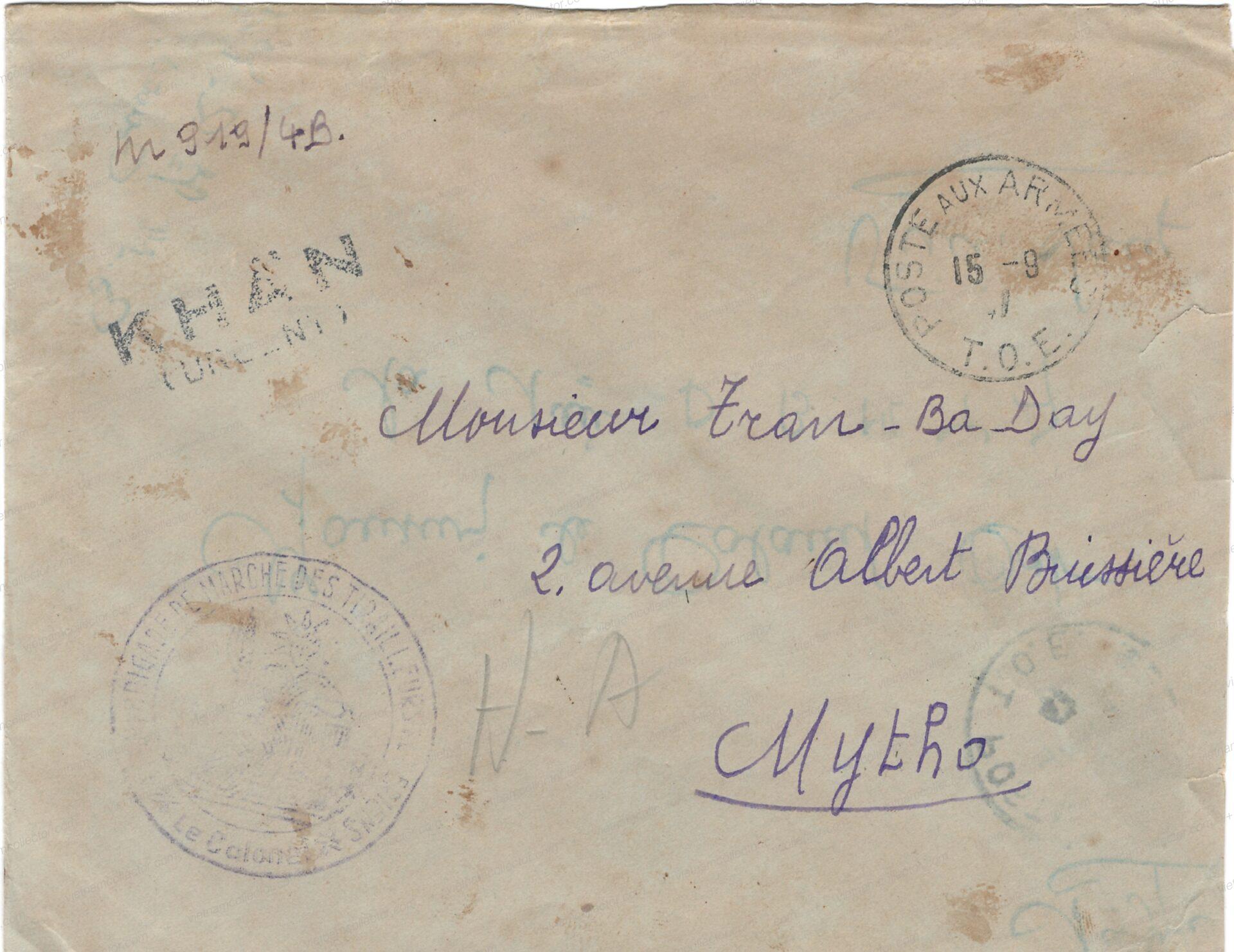
Air mail letter sent by an infrantrist located in Secteur Postale 5072 to France in April of 1948 using the Franchise Militaire free mail privileges. Black military cachet from a Hospital in Cho Quan at top right.
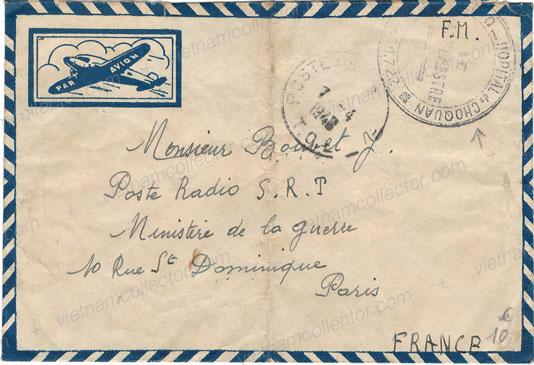 Rare international air mail incoming air mail letters sent from Chailly Enbriere Seine et Marne in France in February of 1948 to a civilian (may be a nurse) located in a hospital in Saigon (BPM 405). The overall postage amounted to 26 FF. Saigon arrival cancel from February 16th, 1948. The letter took only four days to be transported. This is the only sample of incoming mail the editor has yet to find. Incoming mail was often destroyed by the aggressive tropical climate that could destroy paper in a matter of months, the decade long wars and recycling efforts in a country short on raw materials.
Rare international air mail incoming air mail letters sent from Chailly Enbriere Seine et Marne in France in February of 1948 to a civilian (may be a nurse) located in a hospital in Saigon (BPM 405). The overall postage amounted to 26 FF. Saigon arrival cancel from February 16th, 1948. The letter took only four days to be transported. This is the only sample of incoming mail the editor has yet to find. Incoming mail was often destroyed by the aggressive tropical climate that could destroy paper in a matter of months, the decade long wars and recycling efforts in a country short on raw materials.
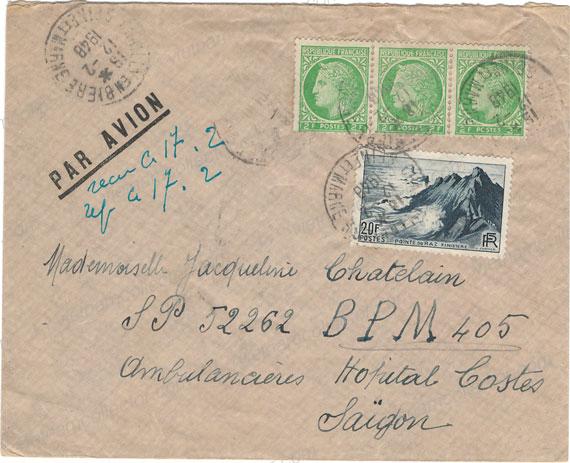
Letter sent by a Austrian Foreign Legionaire in March of 1949 to his family in Austria using the “F.M.” military free frank privileges. Cancelled with the “mute” Poste aux Armees military cancel (Desrousseaux Type C1).Because the letter was not directed to France it had to be up-franked in Paris with a 25 FF stamp. The stamp was cancelled with the mute “Posted aux Armees 222” cancel employed in Paris. Censored in Austria as indicated by the red circular “D” censor cachet on front. The bottom left (red arrow) features a very weak impression of a circular military cachet.
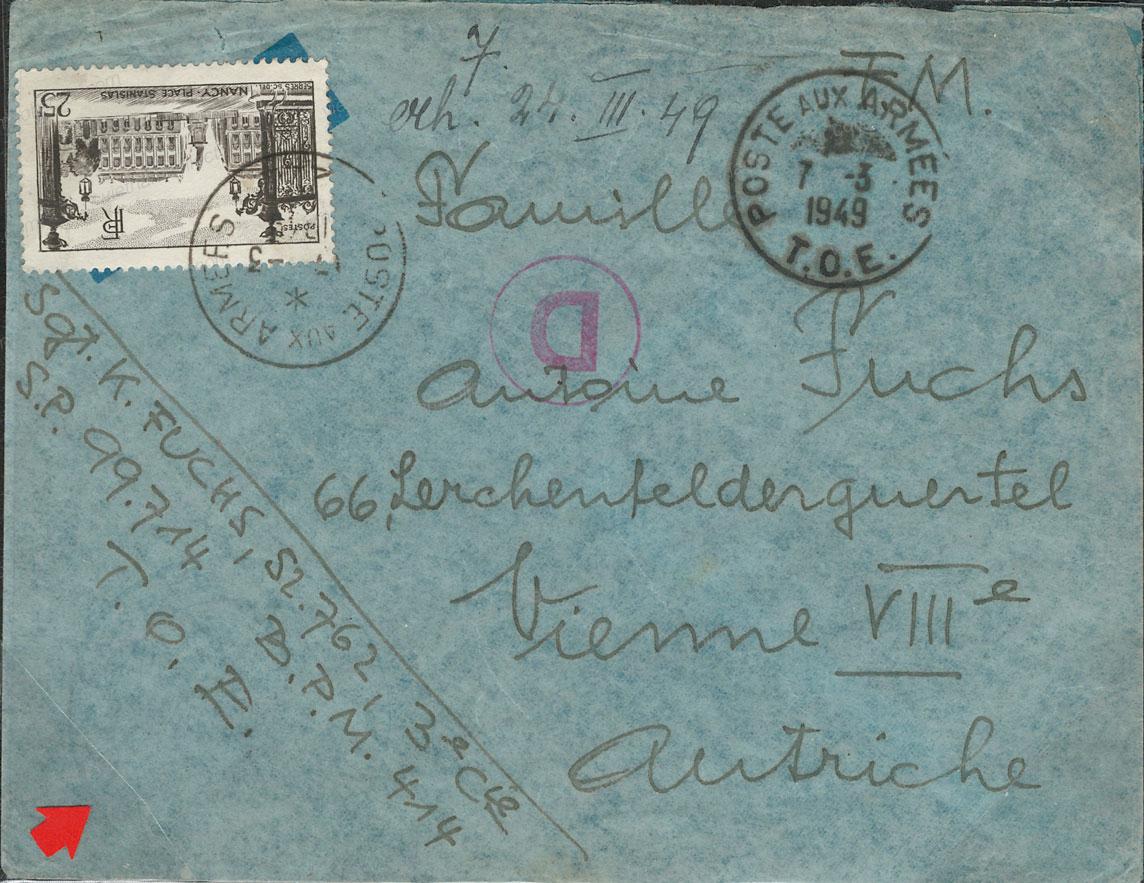
Original photograph of a troop inspection from April 30th, 1948 documented by a Hungarian legionary for his family.
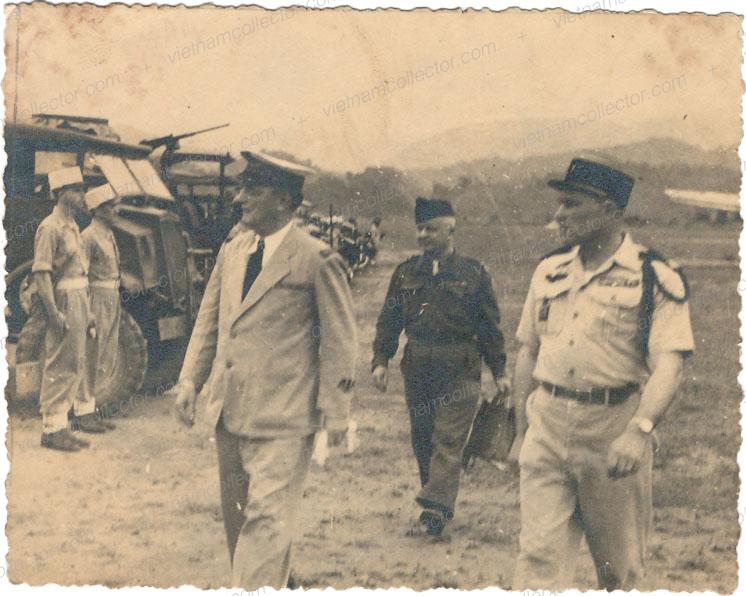
International air mail letter sent in August of 1949 by a Vietnamese civilian and paying an overall postage fo 50FF through a BPM to France. Interestingly the letter was not canceled using the private annex but the mute “Post aux Armee 405” military cancel (Desrousseaux Type L2).
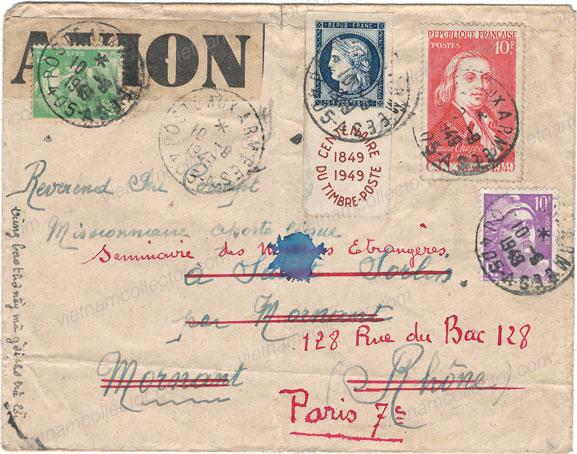 International air mail letter sent by a member of the Republican Guard located in S.P.4103 through BPM 409A to a civilian in France in September of 1949. The sender was apparently an officer so he had to pay a postage of 20 FF. Cancelled with the mute “Poste aux Armees 409 A” civilian annex cancel (Desrousseaux Type L2).
International air mail letter sent by a member of the Republican Guard located in S.P.4103 through BPM 409A to a civilian in France in September of 1949. The sender was apparently an officer so he had to pay a postage of 20 FF. Cancelled with the mute “Poste aux Armees 409 A” civilian annex cancel (Desrousseaux Type L2).
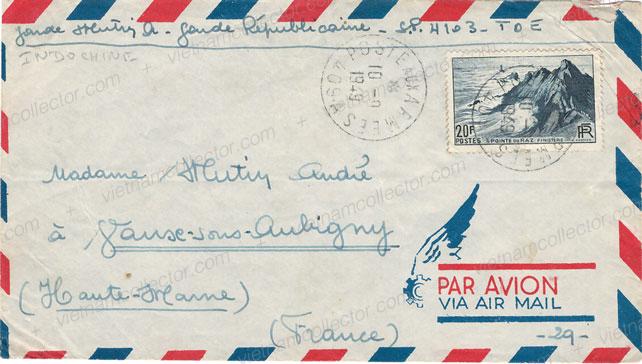
Air mail letter sent by a Seargent Stemmler to Reader Digest in Paris in December of 1949 under the Franchise Militaire (F.M.) free mail privileges. Cancelled with the “mute” Poste aux Armees military cancel (Desrousseaux Type C1).However the postage free transit was only allowed for family communications which did not include Readers Digest. As a result three postage due stamps from France were attached upon arrival in order to collect the additional postage.
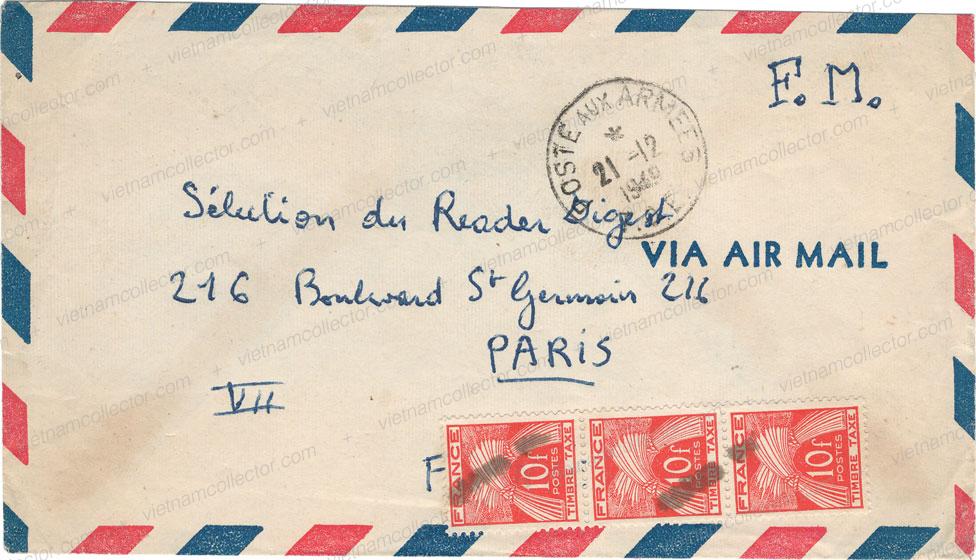
International registered air mail letter sent from S.P.51.006 through the military post office B.P.M. 136 to France in 1950. Canceled with the mute Postes aux Armees 136 cancel. B.P.M. 136 was assigned to Pnom Penh in Cambodia. Franked with a single 50F French stamp due to lack of Indochinese stamps.
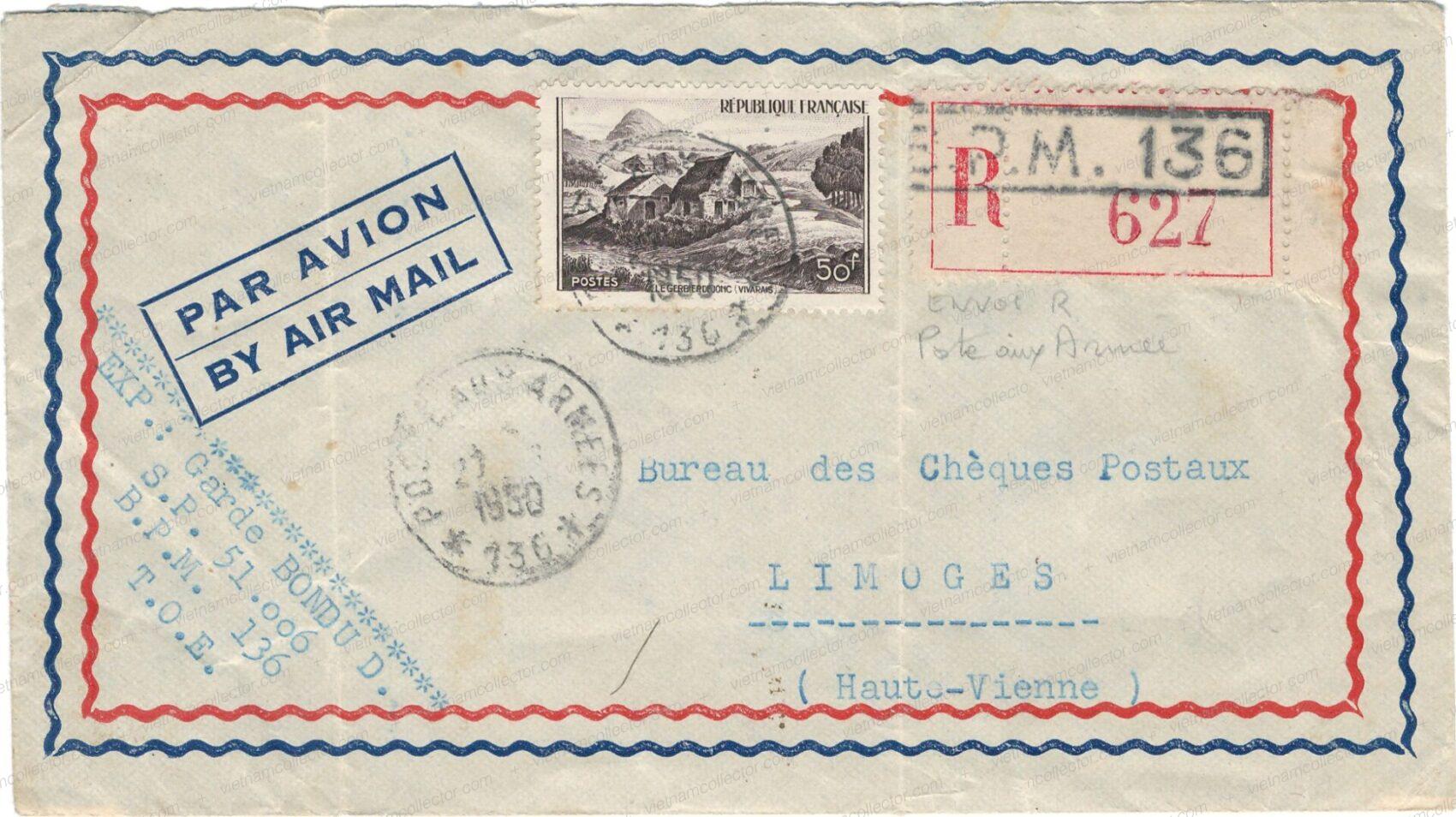
International air mail letter sent by a French soldier located in S.P. 72835 to a civilian in France in January of 1950 using the Franchise Militaire free mail privileges. Cancelled with the “mute” Poste aux Armees military cancel (Desrousseaux Type C1).
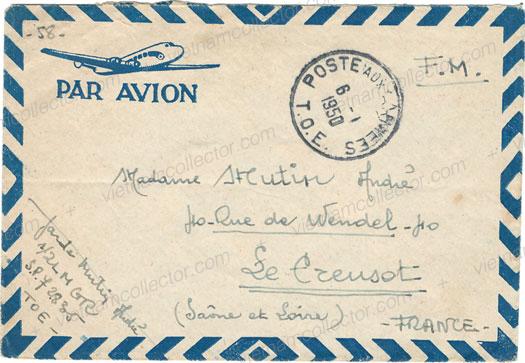
Letter sent by an Austrian member of the French Foreign Legion (S.P. 53342) to a civilian in Vienna, Austria in January of 1950 using the Franchise Militaire (F.M.) free mail privileges. Cancelled with the “mute” Poste aux Armees military cancel (Desrousseaux Type C1). Mail was only transported free of charge within the French Union so this letter addressed outside had to be unfranked by 19 FF upon arrival in Paris before it could be forwarded to the addressee. Red circular “D” and blue “U” censure cachets on front.
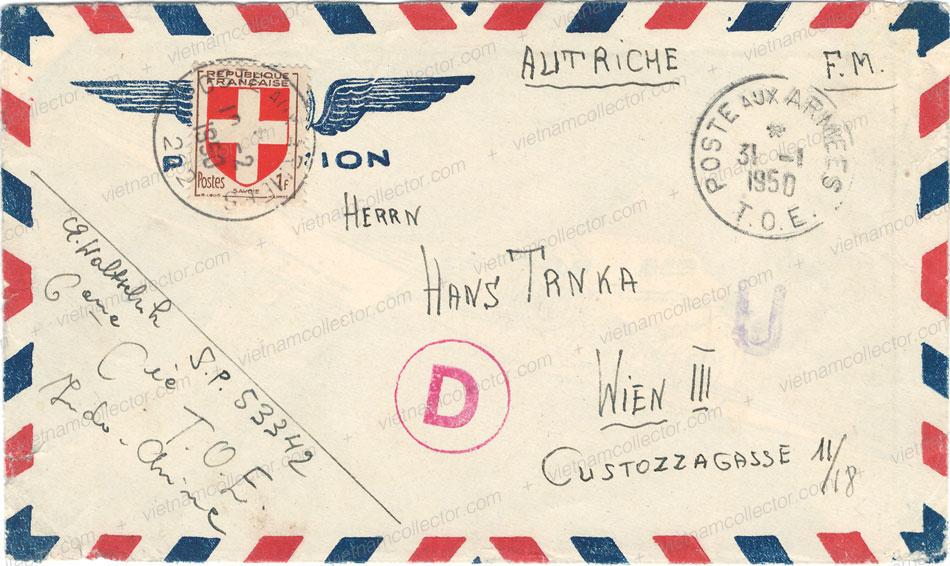
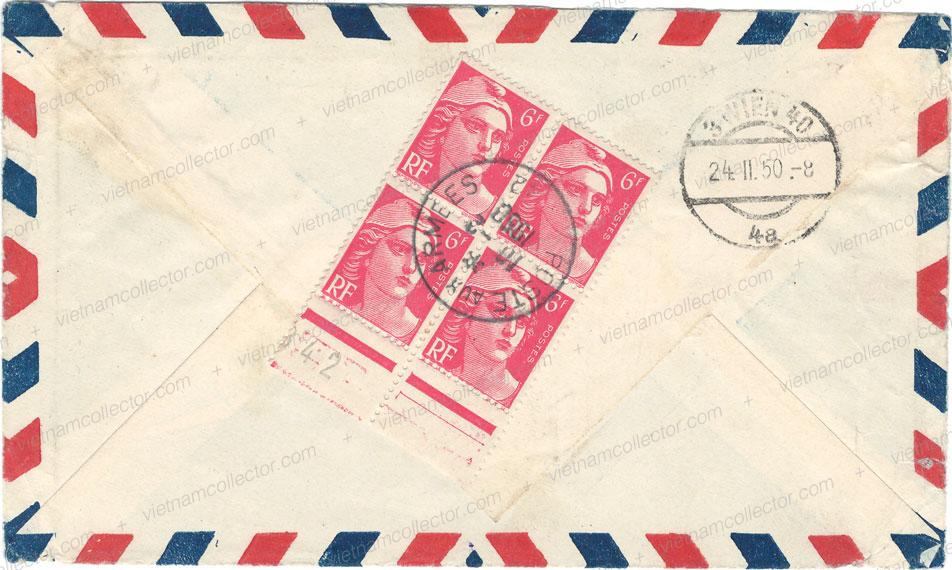 Letter sent by a German member of the French Foreign Legion sent in May of 1950 using the Franchise Militaire free frank privilege (F.M.) sent to a civilian in Germany. Cancelled with the “mute” Poste aux Armees military cancel (Desrousseaux Type C1). Since the free military mail was only allowed within the French territory letters sent outside thereof had to be franked according to UPU regulations. As a result they were centrally forwarded to BPO 222 in Paris, were standard French postage stamps were attached (25 FF) and canceled. The lettre was posted on May 3rd and it was processed in Paris on May 9th, only six days later.
Letter sent by a German member of the French Foreign Legion sent in May of 1950 using the Franchise Militaire free frank privilege (F.M.) sent to a civilian in Germany. Cancelled with the “mute” Poste aux Armees military cancel (Desrousseaux Type C1). Since the free military mail was only allowed within the French territory letters sent outside thereof had to be franked according to UPU regulations. As a result they were centrally forwarded to BPO 222 in Paris, were standard French postage stamps were attached (25 FF) and canceled. The lettre was posted on May 3rd and it was processed in Paris on May 9th, only six days later.
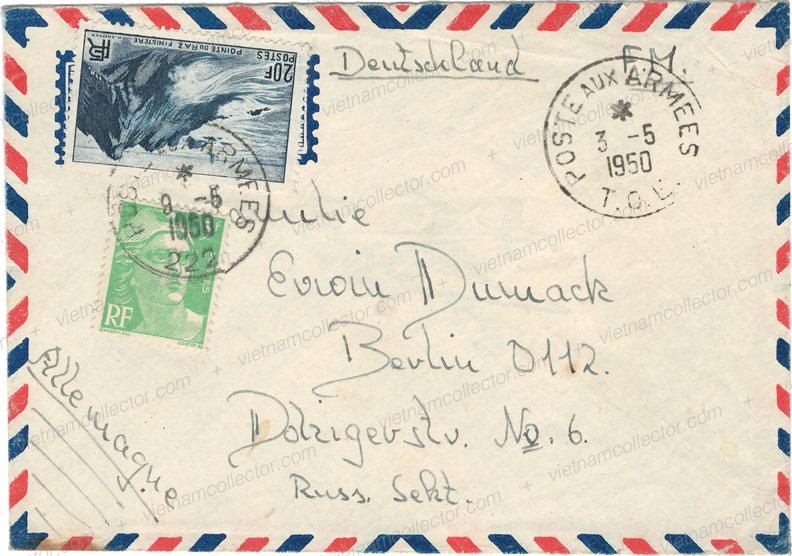
International air mail letter front sent Quang Yen (just outside of Hai Phong) in July of 1950 to a civilian in France using the Franchise Militaire free mail privileges. Why the civilian postal system instead of the military system with its mute cancels was used is not clear. Highly unusual.
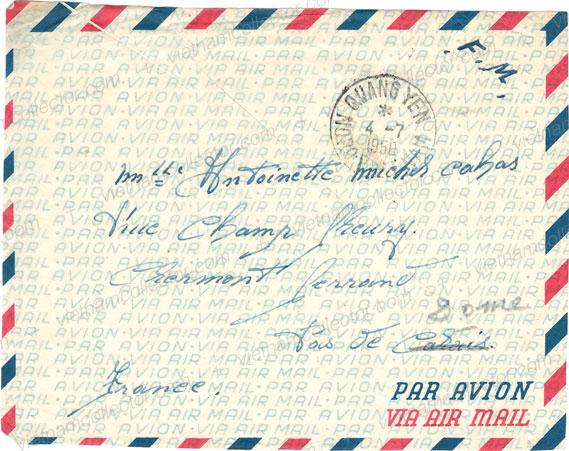 International letter sent in February of 1950 by a German soldier in the Foreign legion located in S.P. 80.506 to a civilian in Germany. Cancelled with the “mute” Poste aux Armees military cancel (Desrousseaux Type L1).The letter was processed through the French military postal system and cancelled with the mute “Poste aux Armees 222” mute canceler applied by the Central Post Office in Paris . The stamp had to be added in Paris as the letter was addressed to outside of France.
International letter sent in February of 1950 by a German soldier in the Foreign legion located in S.P. 80.506 to a civilian in Germany. Cancelled with the “mute” Poste aux Armees military cancel (Desrousseaux Type L1).The letter was processed through the French military postal system and cancelled with the mute “Poste aux Armees 222” mute canceler applied by the Central Post Office in Paris . The stamp had to be added in Paris as the letter was addressed to outside of France.
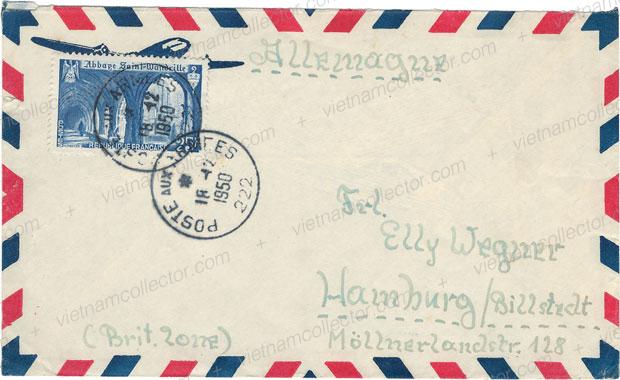
International letter sent in December of 1950 by a soldier located in S.P. 50.630 to a friend in Belgium (full contents preserved). The letter was processed through the French military postal system and cancelled with the mute “Poste aux Armees” mute canceler (Desrousseaux Type L1) but had to be up-franked with 25 FF France as it was not directed to France. Note the military insignia at the top left.
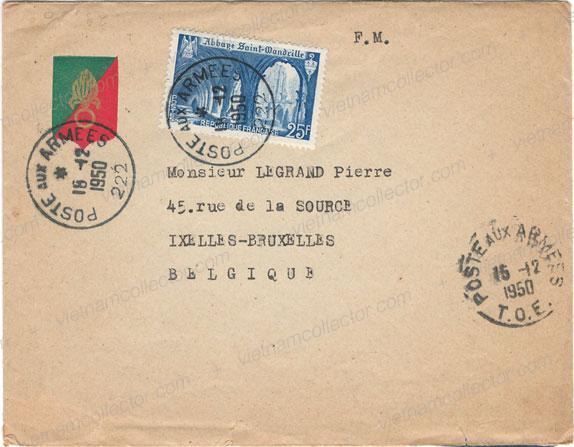
International letter sent in December of 1950 by a soldier located in S.P. 54.285 to a civilian in Austria. The letter was processed through the French military postal system (BPM 403) and cancelled with the mute “Poste aux Armees. TOE” mute canceler but had to be up-franked with 25 FF France as it was not directed to France. The stamp was cancelled with the mute “Poste aux Armees 222” cancel (Desrousseaux Type L1) that was used in Paris.
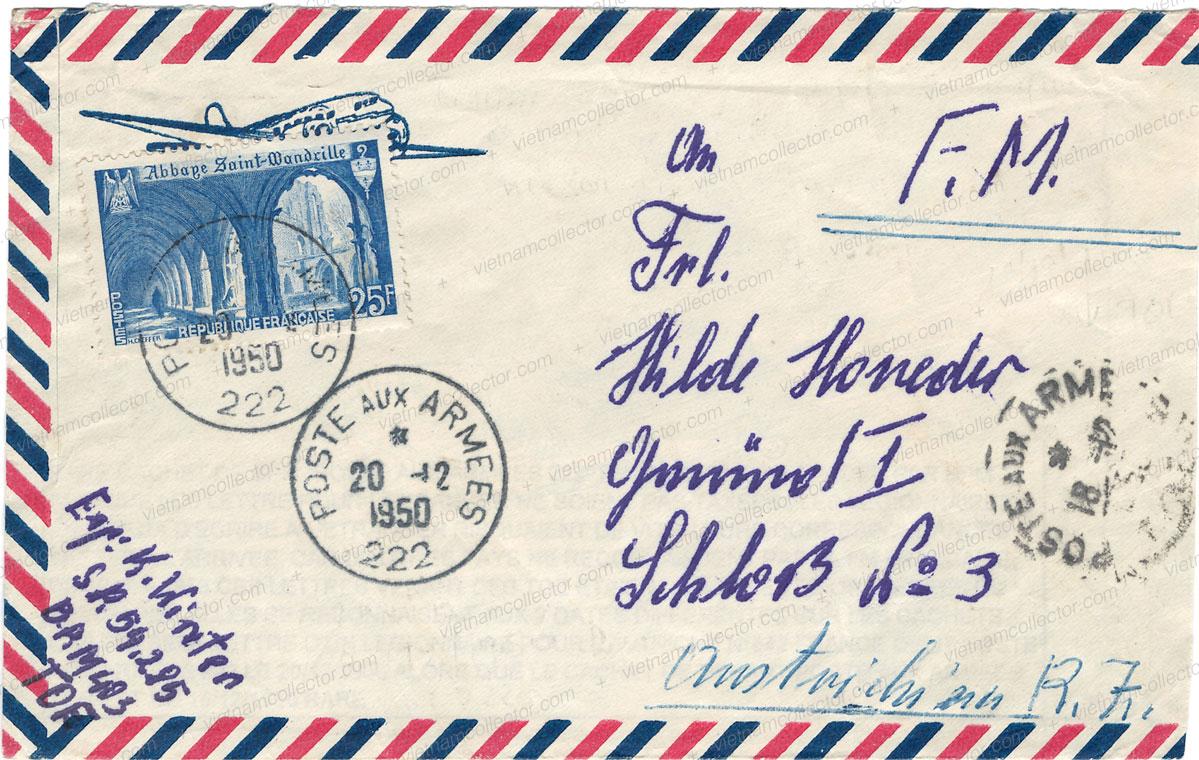
International letter sent in December of 1950 by a soldier located in S.P. 57.672 to a civilian in Belgium. The letter was processed through the French military postal system and cancelled with the mute “Poste aux Armees” mute canceler but had to be up-franked with 25 FF France as it was not directed to France. The stamp was cancelled with the mute “Poste aux Armees 222” cancel (Desrousseaux Type L1) that was used in Paris.

Single franking of 30 FF stamp on an international air mail letter sent by a German member of the French Foreign Legion sent from S.P.72.804 in Indochina to a newspaper in Hannover. The stamp, which was added in France, was required as the letter did go abroad. Cancelled in Paris with the Central Post Office cancel “222” (Desrousseaux Type L1). Hannover was located in the British Zone in occupied Germany at the time. Cancelled with the mute “Poste aux Armees” military cancel.
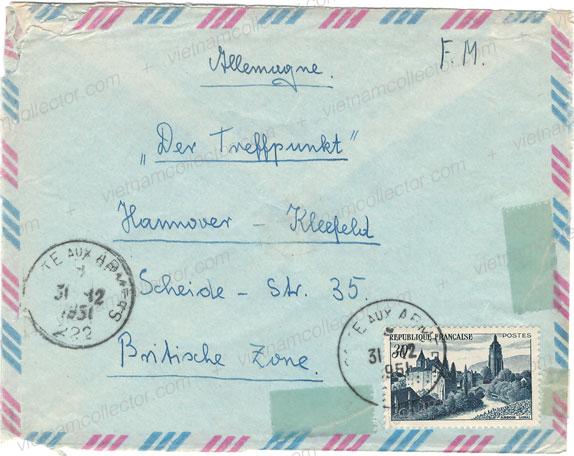
Civilian homemade letter carrying a mixed ranking of 15 FF on a surface letter sent through BPM 413 A from Pleiku to France in December of 1951. Cancelled with the ute “Poste aux Armees” military cancel (Desrousseaux Type K1).
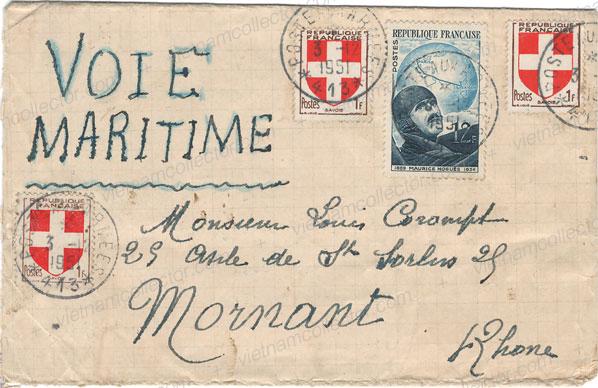
Letter by the “Chef de Mission” using the military free frank privileges sent to a civilian in France in August of 1951. Cancelled by the mute “Poste aux Armees” military cancel (Desrousseaux Type C1).
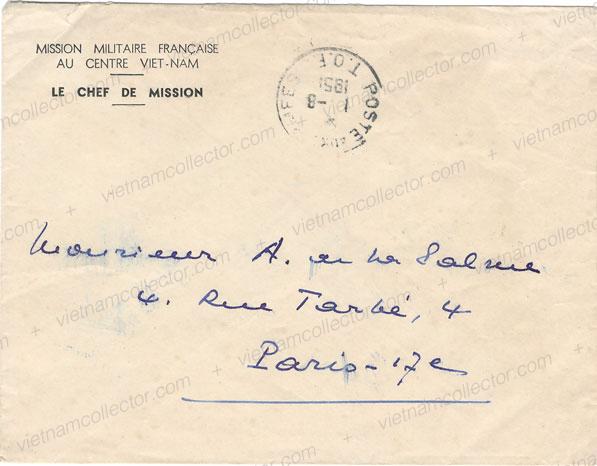
Letter sent by a French soldier employed in a Vietnamese Battalion located in S.P. 50.512 to a civilian in France using the postage free mail privileges in February of 1952. Cancelled with the “mute” Poste aux Armees military cancel (Desrousseaux Type C1).Red circular military cachet on bottom left.
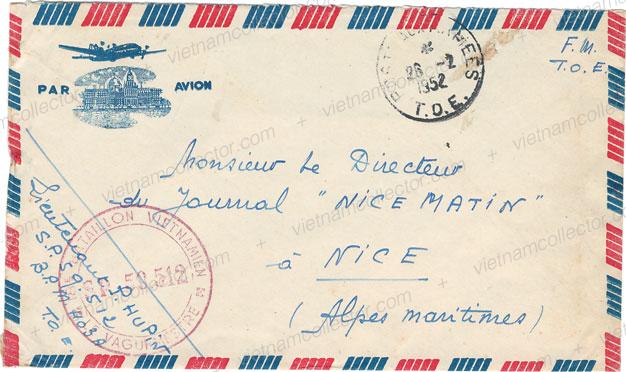
Rare incoming mail franked with a single 15 FF stamp sent by a French radio station to a soldier located in S.P. 4887 (T.O.E.) in June of 1952.
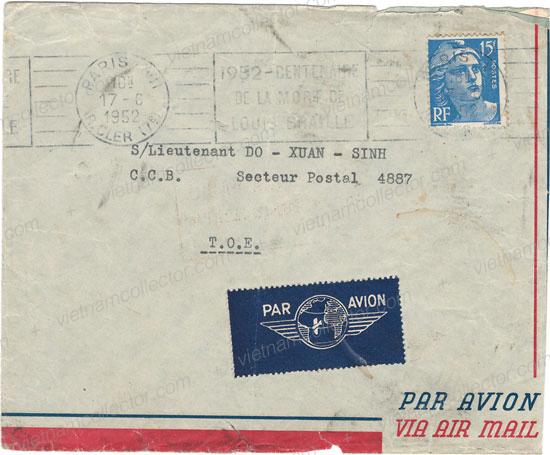
Letter sent by a German member of the Foreign legion using the Franchise Militaire (F.M.) free mail privilege in September of 1952. Postage free mail was limited to within the French Union, so according to UPU regulations the letter had to be upfranked in Paris with 30FF before it could be forwarded to the addressee. Cancelled with the “mute” Poste aux Armees military cancel. The cancel looks like a type Desrousseaux B1 but shows the year as “1952”. Unlisted in Desrousseaux’ Book 4.
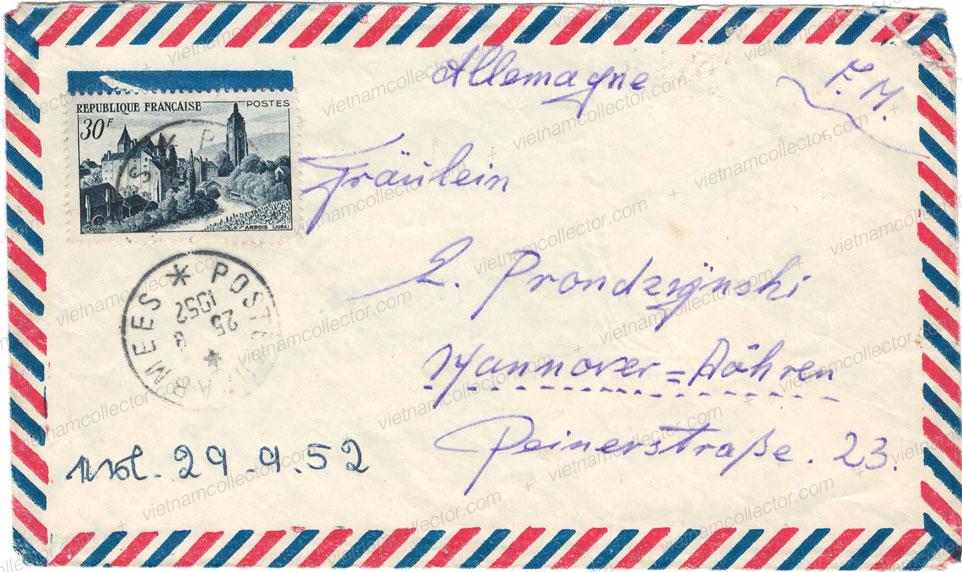
International letter (full contents preserved) sent by a French soldier (S.P. 50663) sent in June of 1953 to a civilian in Paris using the Franchise Miitaire (F.M.) free mail privileges. Cancelled by the “mute” Postes aux Armees T.O.E. military cancel (Desrousseaux Type C1).
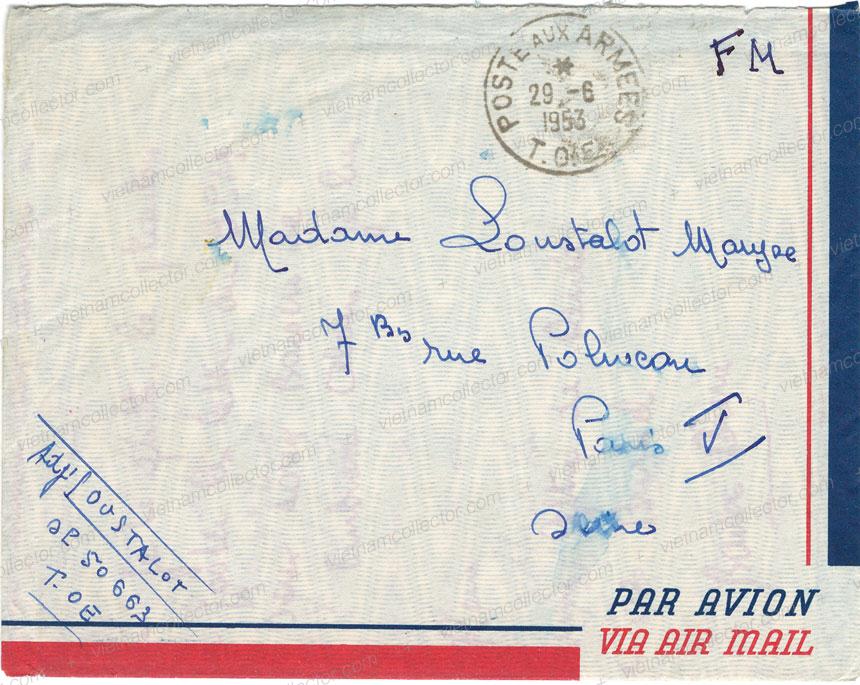
International letter sent by a French soldier (S.P. 50663) sent in September of 1953 to a civilian in Paris using the Franchise Miitaire (F.M.) free mail privileges. Cancelled by the “mute” Postes aux Armees T.O.E. military cancel (Desrousseaux Type D).
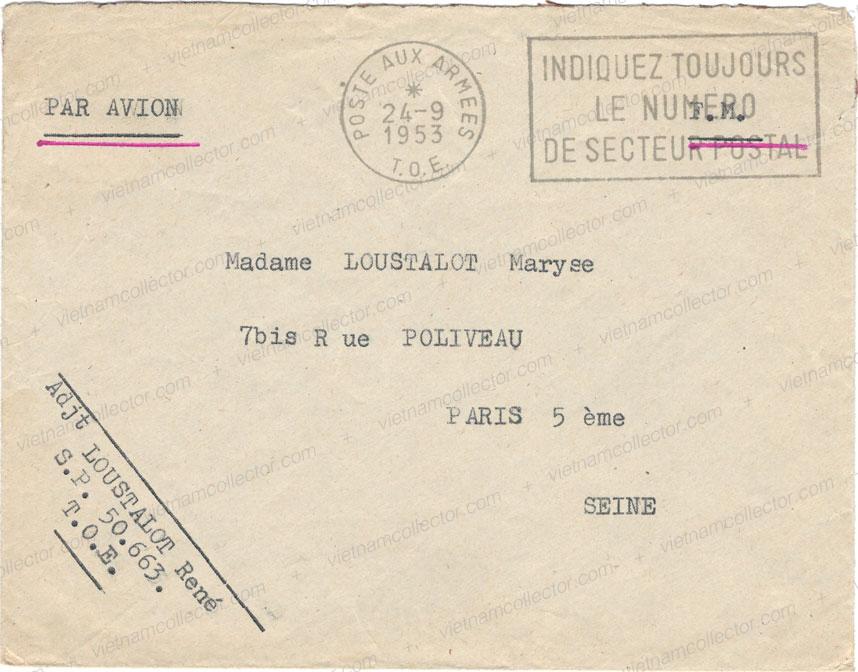
Domestic letter sent by a Vietnamese brigade of the French (KBC 4027/Nationakl Military Academy in Dalat) sent in October of 1953 to a civilian in Hanoi using the Franchise Miitaire (F.M.) free mail privileges. Cancelled by the “mute” Postes aux Armees T.O.E. military cancel (Desrousseaux Type C1).
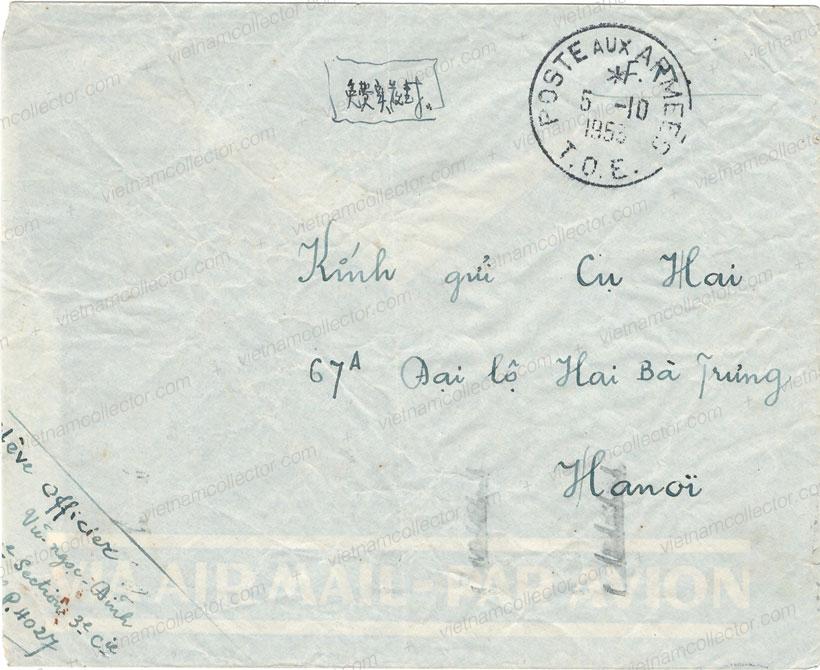
Domestic letter sent by a Vietnamese brigade of the French (KBC 4056) sent in September of 1954 to a civilian in Hanoi using the Franchise Miitaire (F.M.) free mail privileges. Cancelled by the “mute” Postes aux Armees T.O.E. military cancel (Desrousseaux Type D).
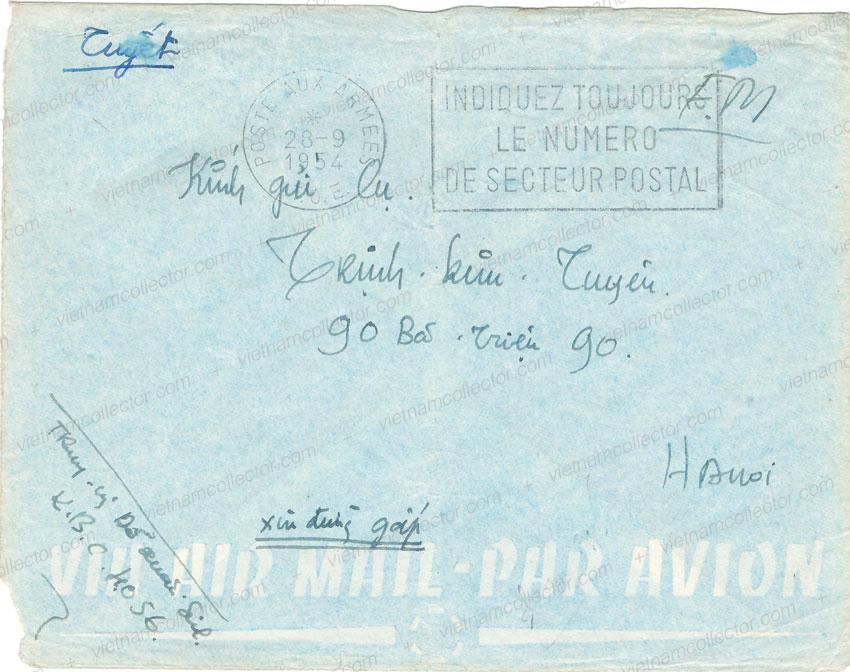
Commemorative envelope of the “mute” Poste aux Armees cancel struck on the date the French troops withdrew from Hanoi. Cancelled with the “mute” Poste aux Armees military cancel (Desrousseaux Type C1).
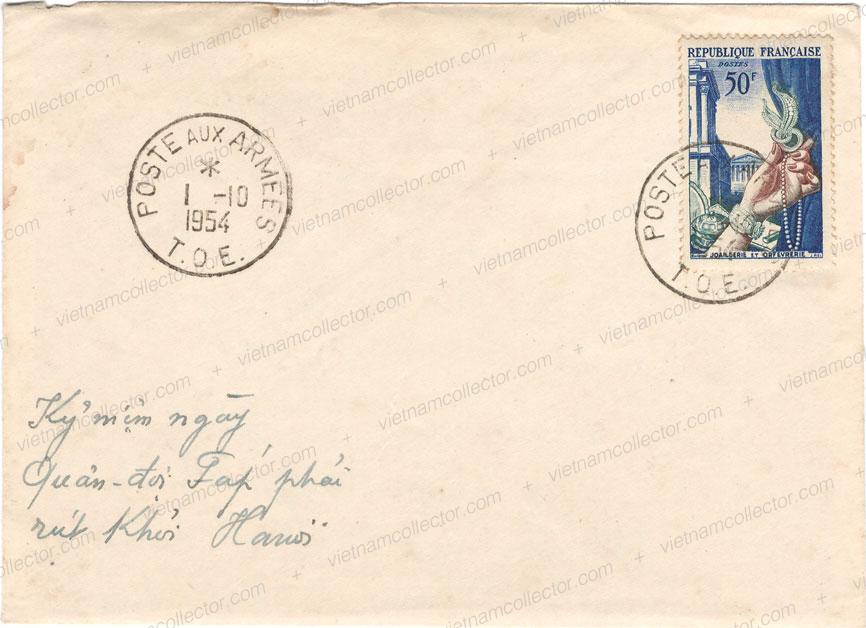
Mixed franking of French stamps paying an overall postage of 54 FF on a registered international air mail letter sent by a Major located in S.P. 63.902 to the well known philatelist Theo Klewitz in West Germany in February of 1955. Cancelled with the “mute” Poste aux Armees military cancel (Desrousseaux Type C1).The letter had to be franked due to the officer rank of the solider and the fact that the letter went to a foreign country.
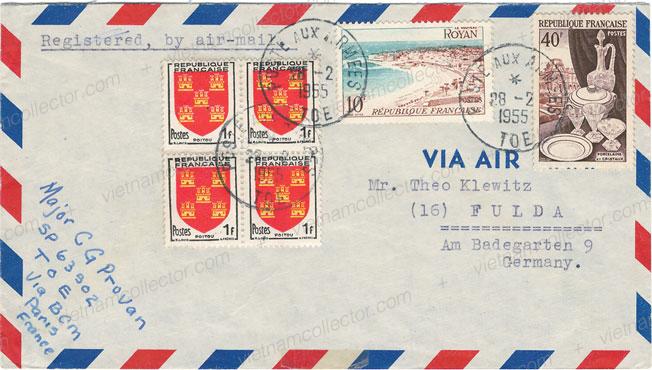
Single franking of a 50FF French postage stamp used on a registered letter sent by a Vietnamese doctor from the military hospital in Nha Trang to a company in France in February of 1955. Rare “SP 63 411” R-label on front. Cancelled with the “mute” Poste aux Armees military cancel (Desrousseaux Type C1). Paris arrival cancel on the reverse. The letter had to be franked as it was not directed to “family” but a business corporation.
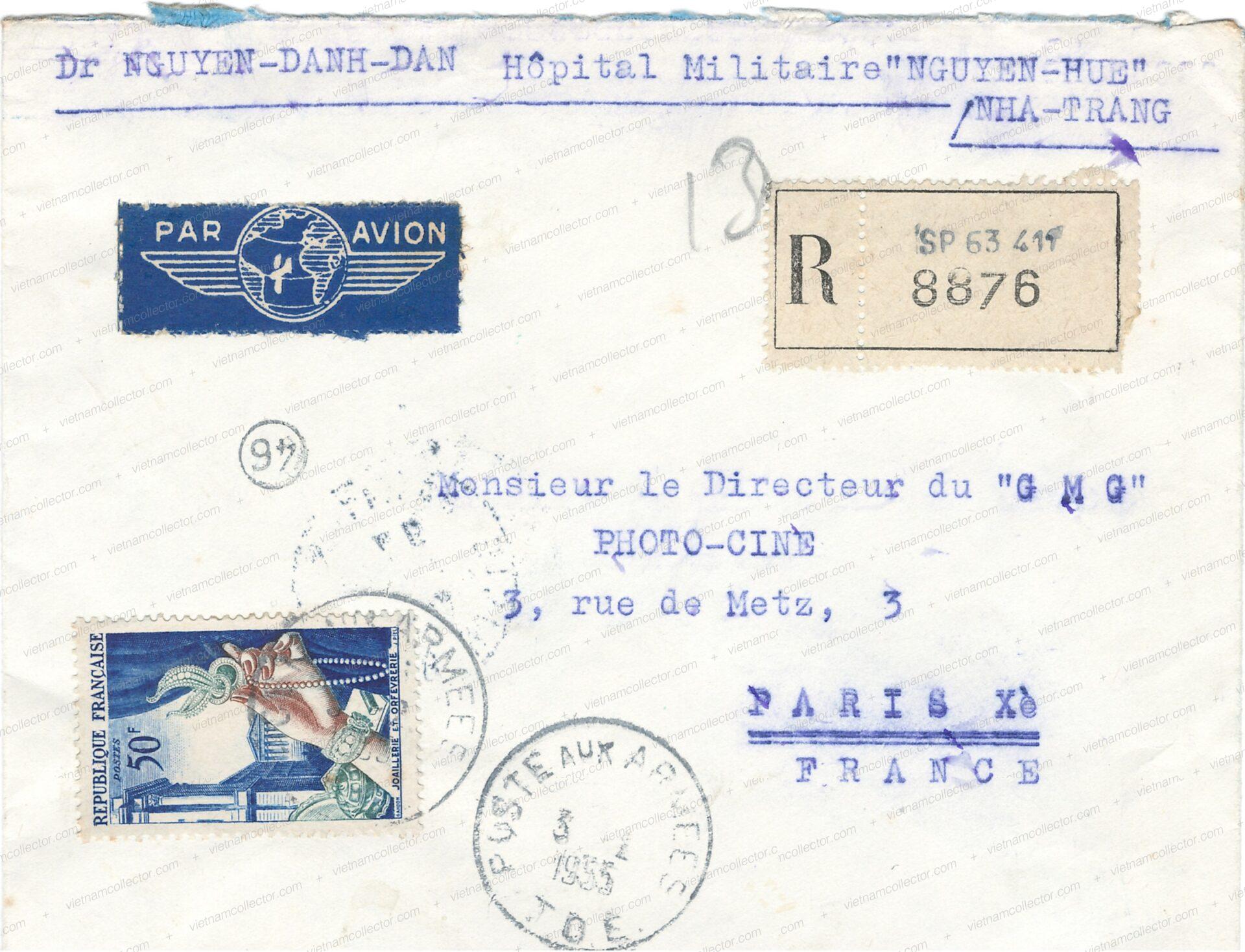
Desrousseaux writes in the SICP Journal 13: “The post offices in North Vietnam closed when the French left Hanoi on Oct. 9, 1954 and Haiphong in May 1955. The last one in South Vietnam, Saigon, was transferred to the Vietnam Army in June 1955. However, we know of further French military covers from Saigon as late as 1958 from the military physicians of Hospital Grail. In Cam- bod.la and Laos, French military post offices existed until the pre- sent.”
Military correspondence sent from S.P. 4545 and applying an unusual red “S.M.” (Service Militaire) that probably was replacing the usual handwritten F.M. (Franchise Militaire) remark. Sent to France in March of 1955. Cancelled with the “mute” Poste aux Armees military cancel (Desrousseaux Type D).
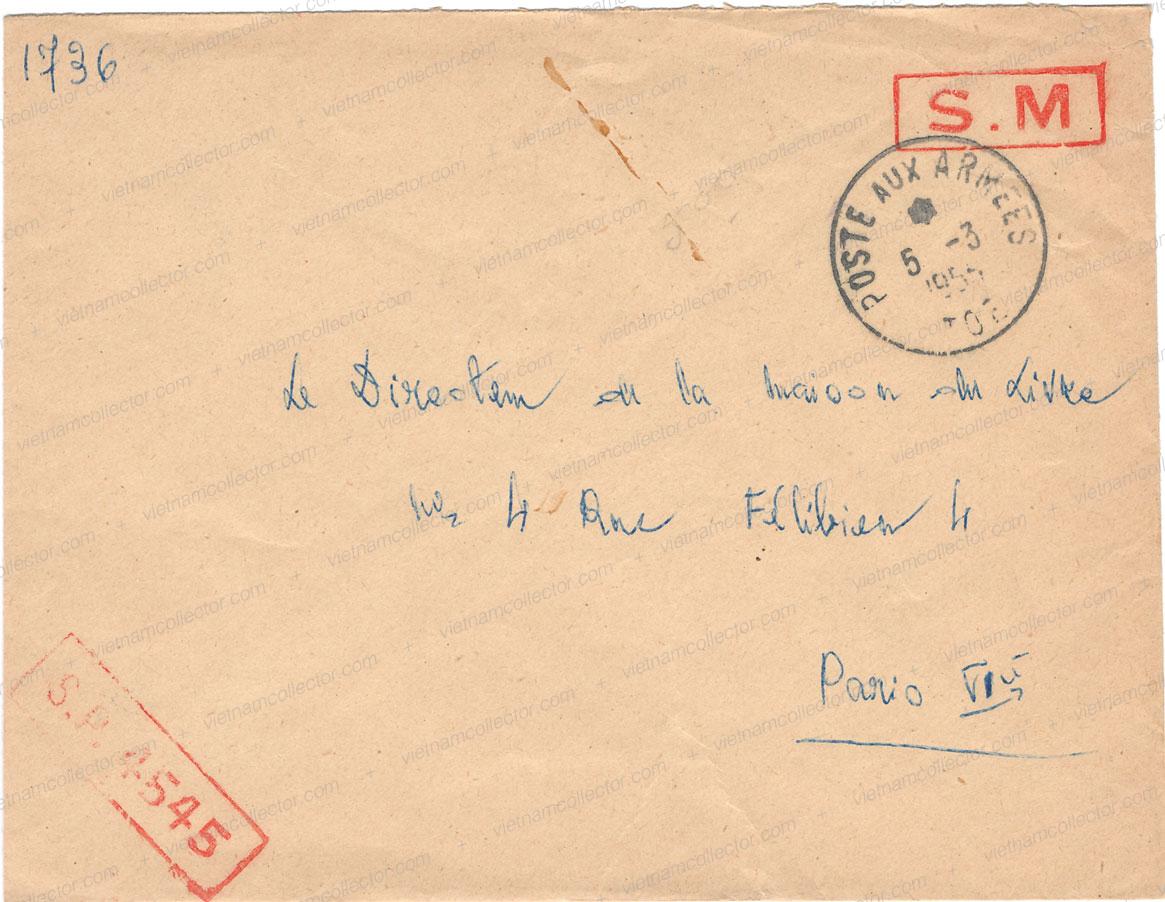
Here is a surface letter sent in April of 1955, just days before the last French military post office was handed over to the Vietnamese. It must have been sent by a solider with officer rank as it was franked with two 25 FF stamps paying an overall postage of 50 FF. Cancelled with the “mute” Poste aux Armees military cancel (Desrousseaux Type D).
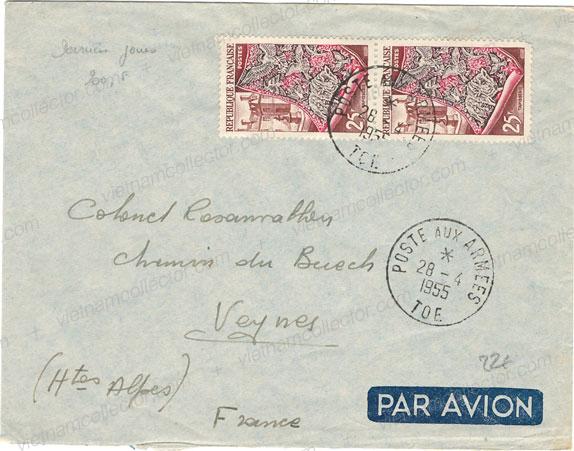
Letter (full contents preserved) sent by a French soldier attached to S.P. 54.047A in Hanoi to a civilian in Saigon using the French military postal system and the Franchise Militaire (F.M.) free mail priviledges. This letter from May 23rd, 1955 must have been one of the last few letters processed through the Hai Phong military post office before it was closed. Cancelled with the “mute” Poste aux Armees military cancel (Desrousseaux Type D).
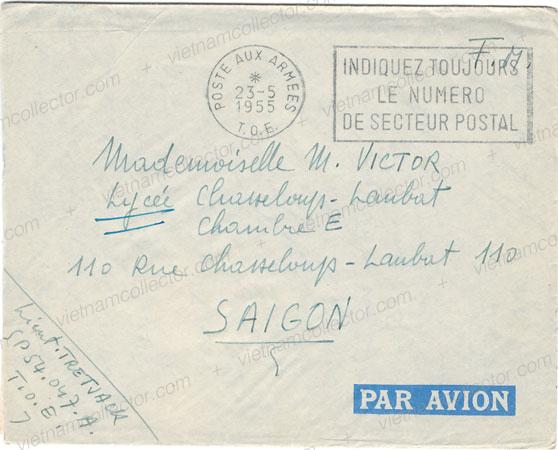
Registration Nr. 099998

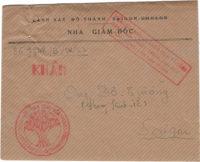
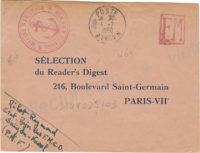
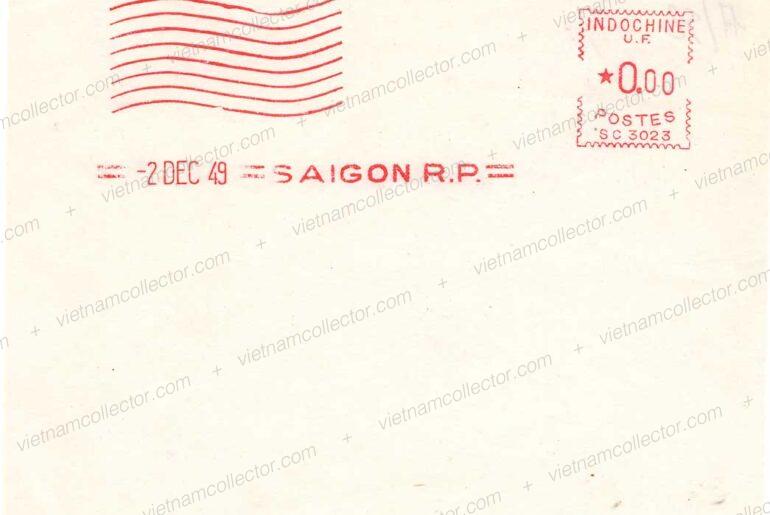
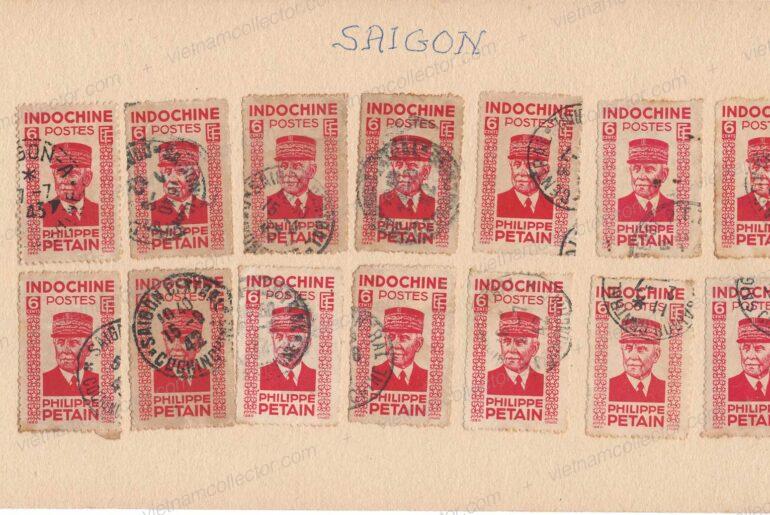
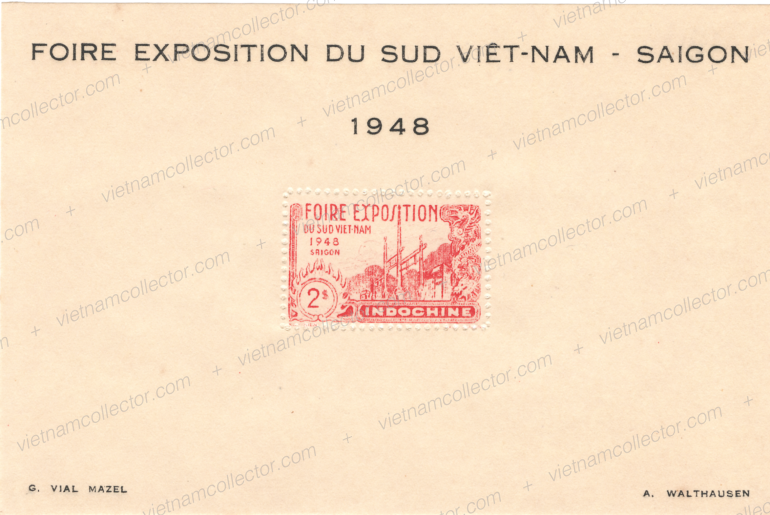
Comments are closed.